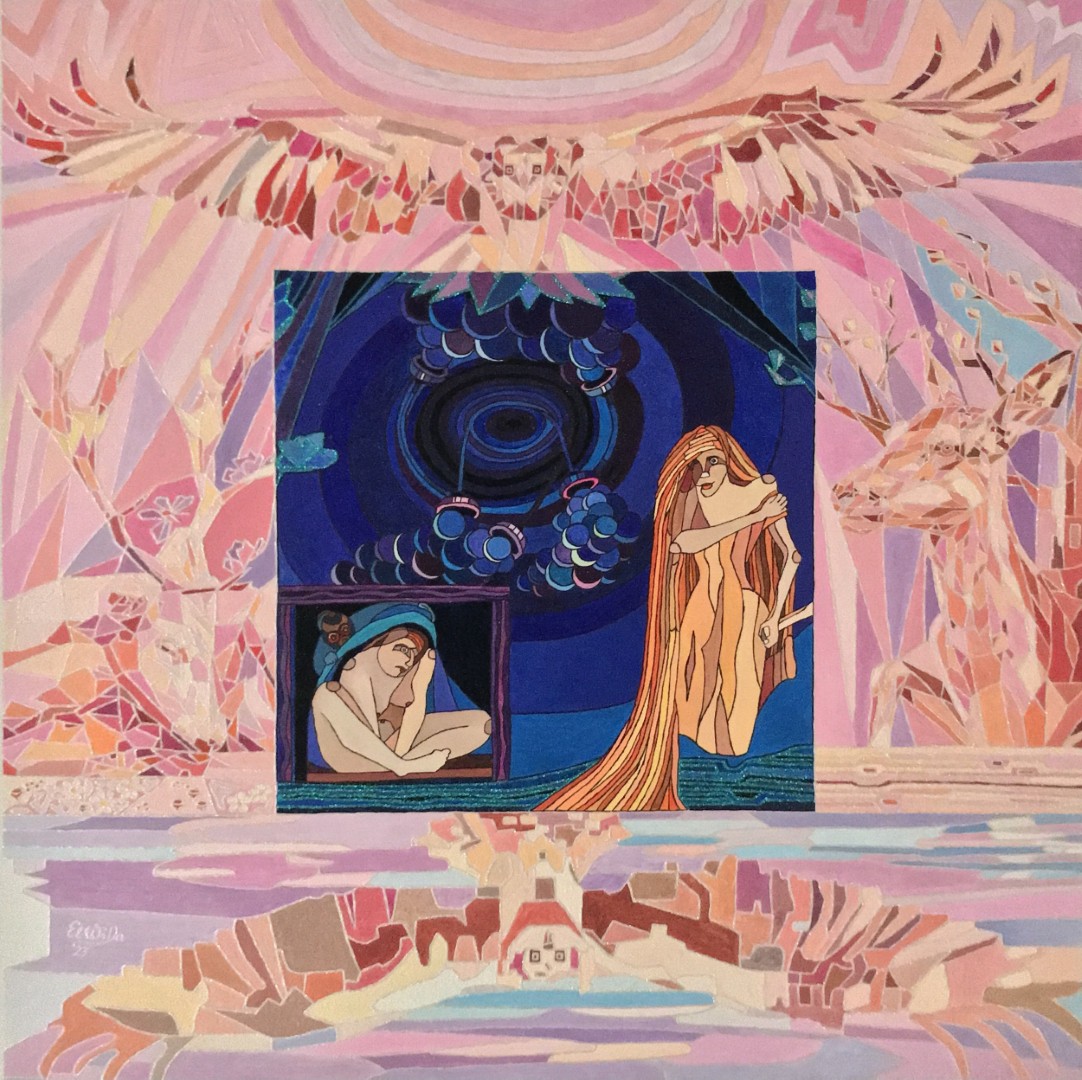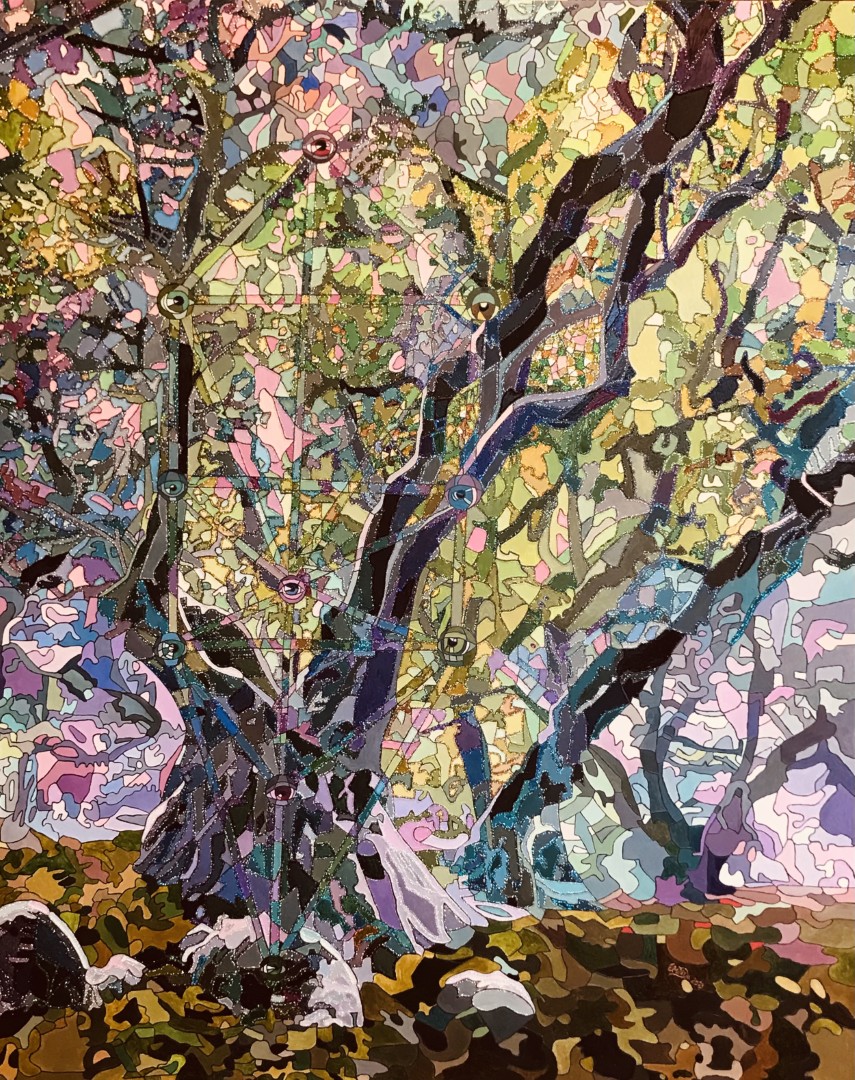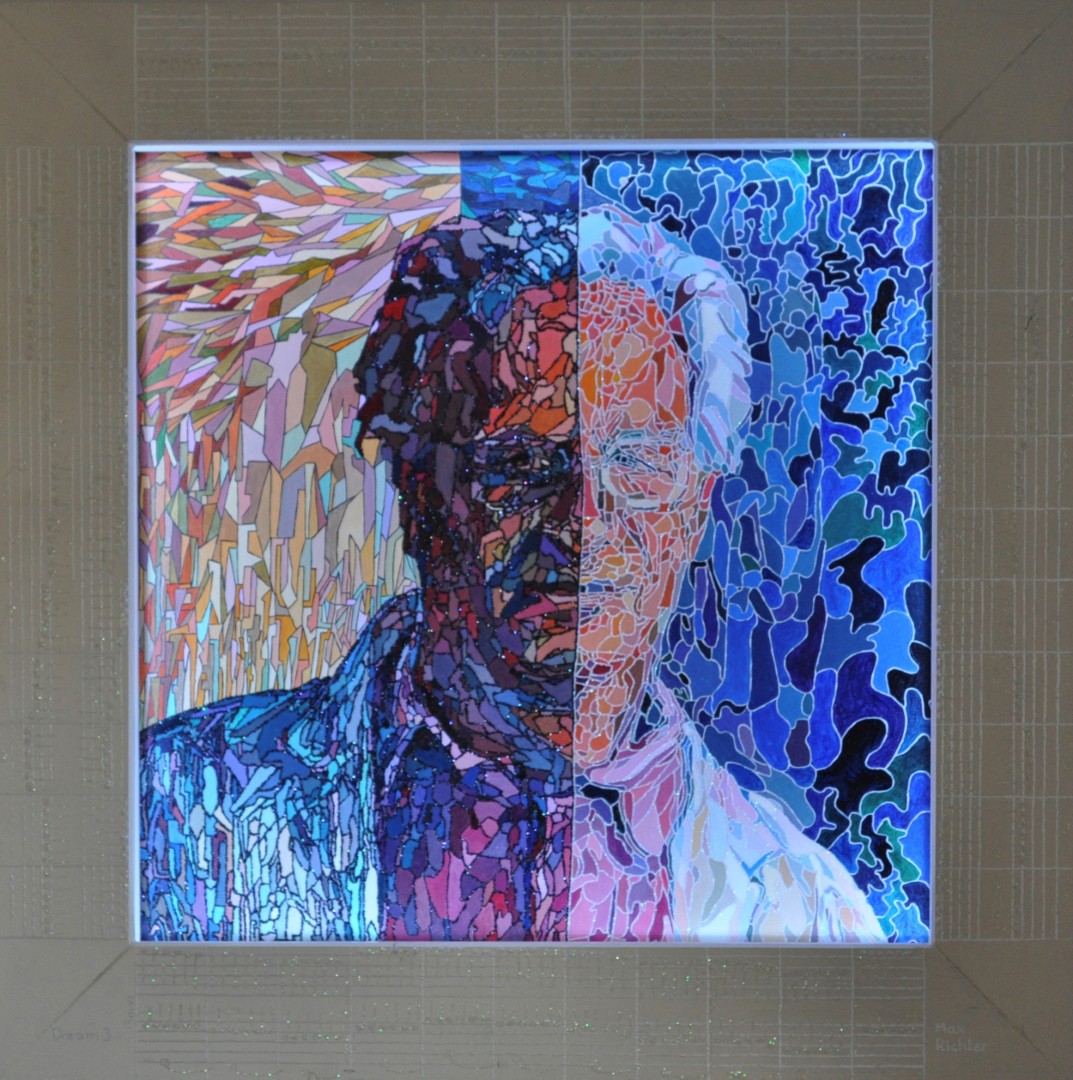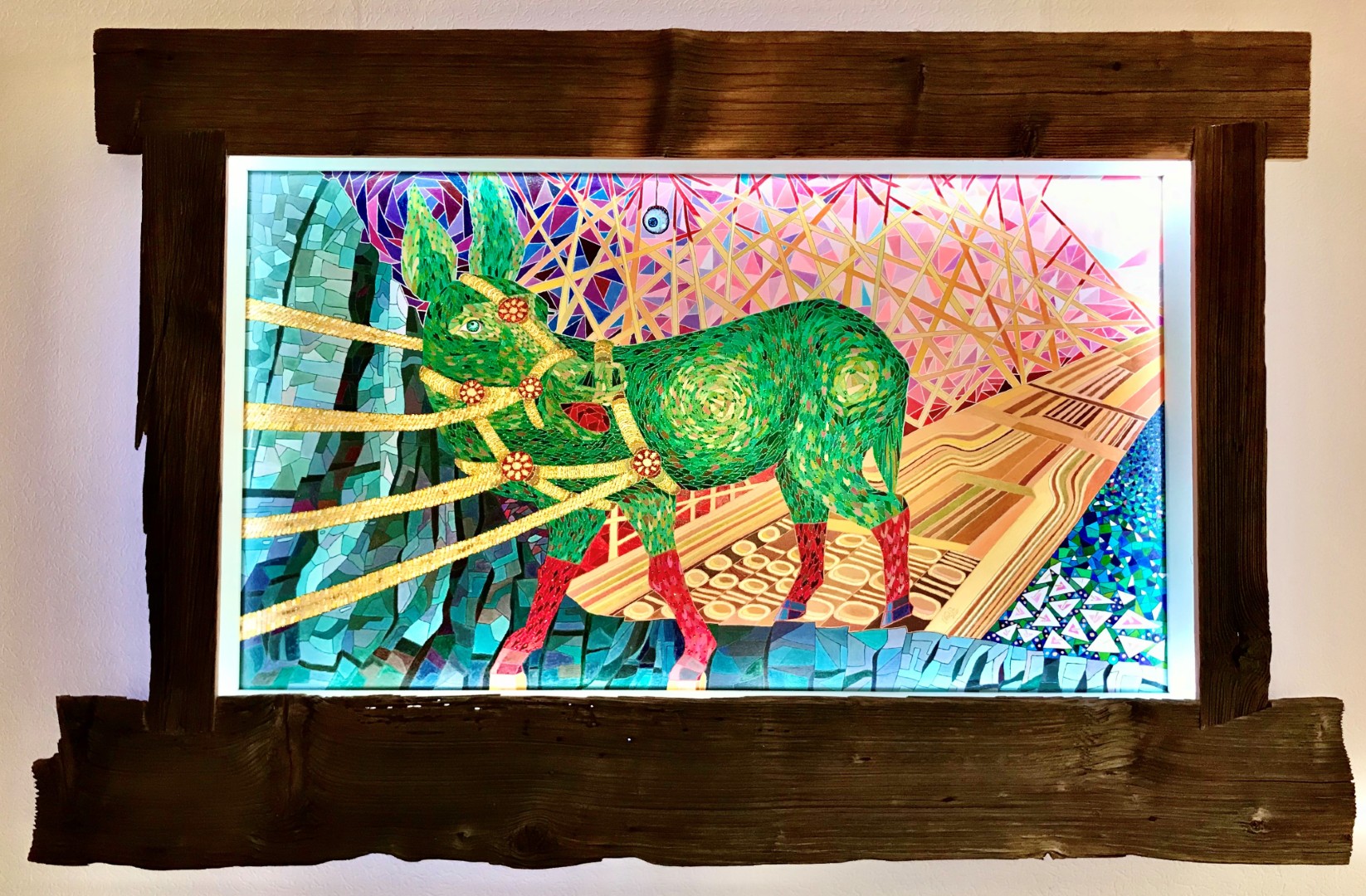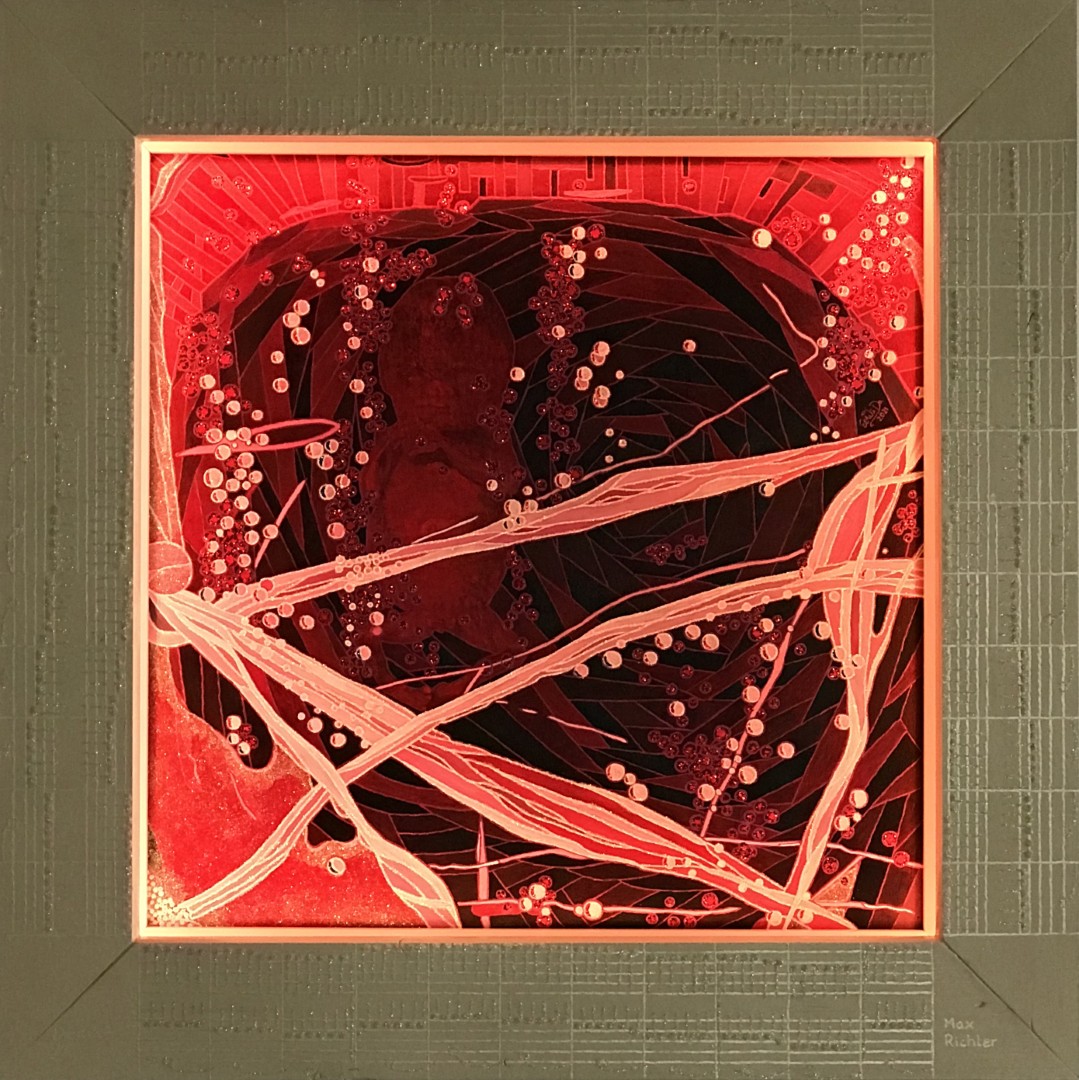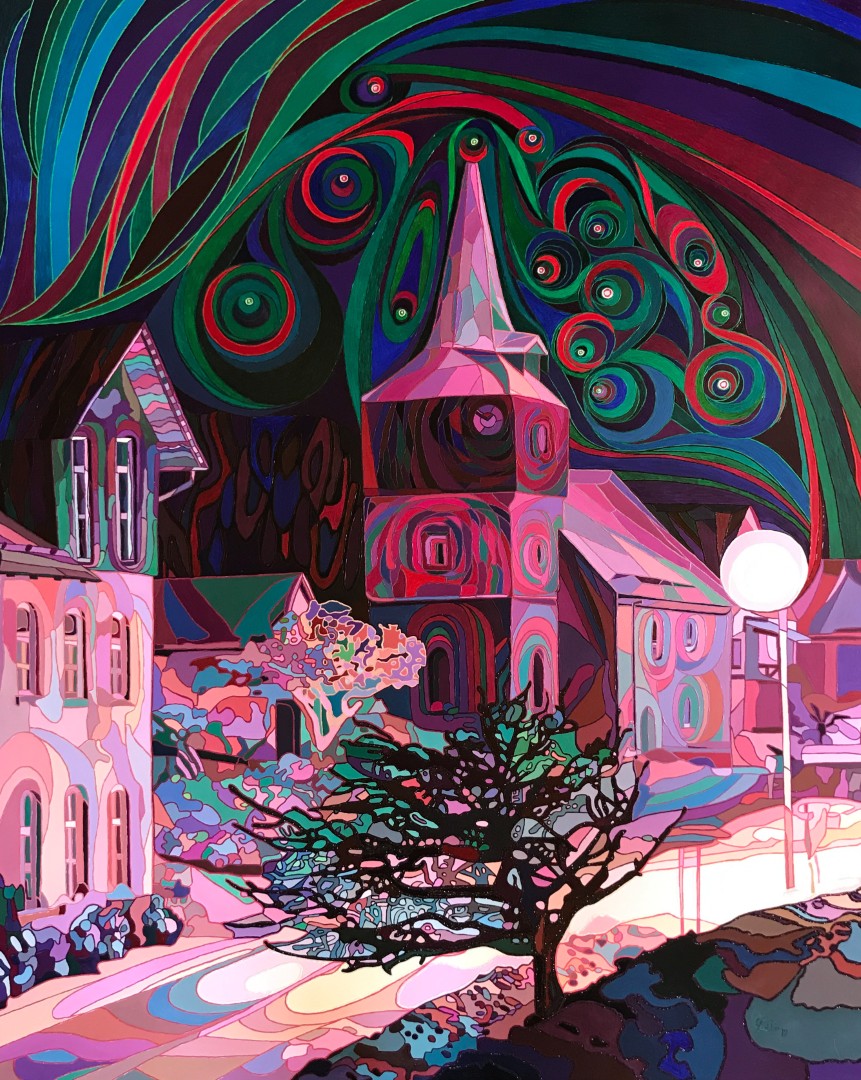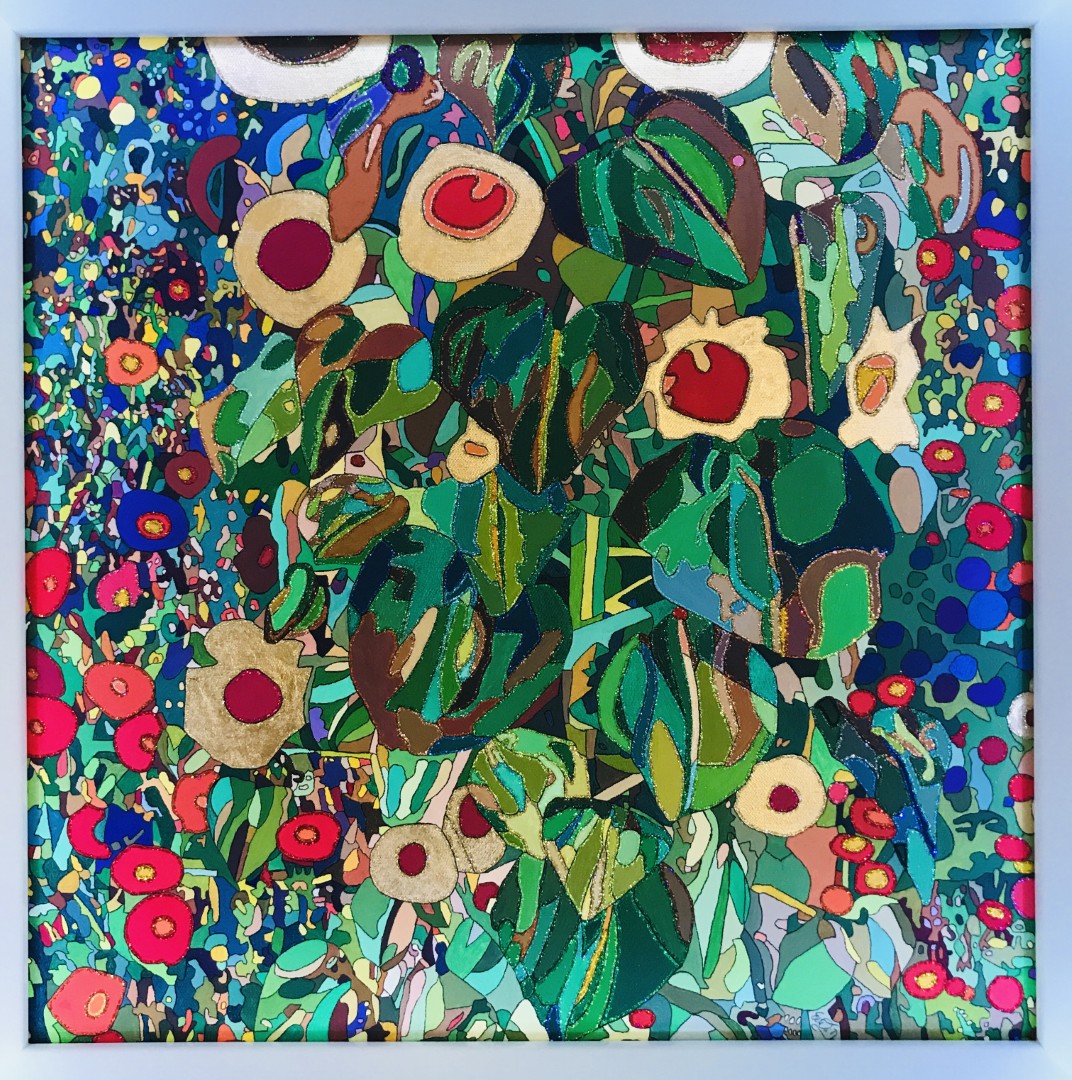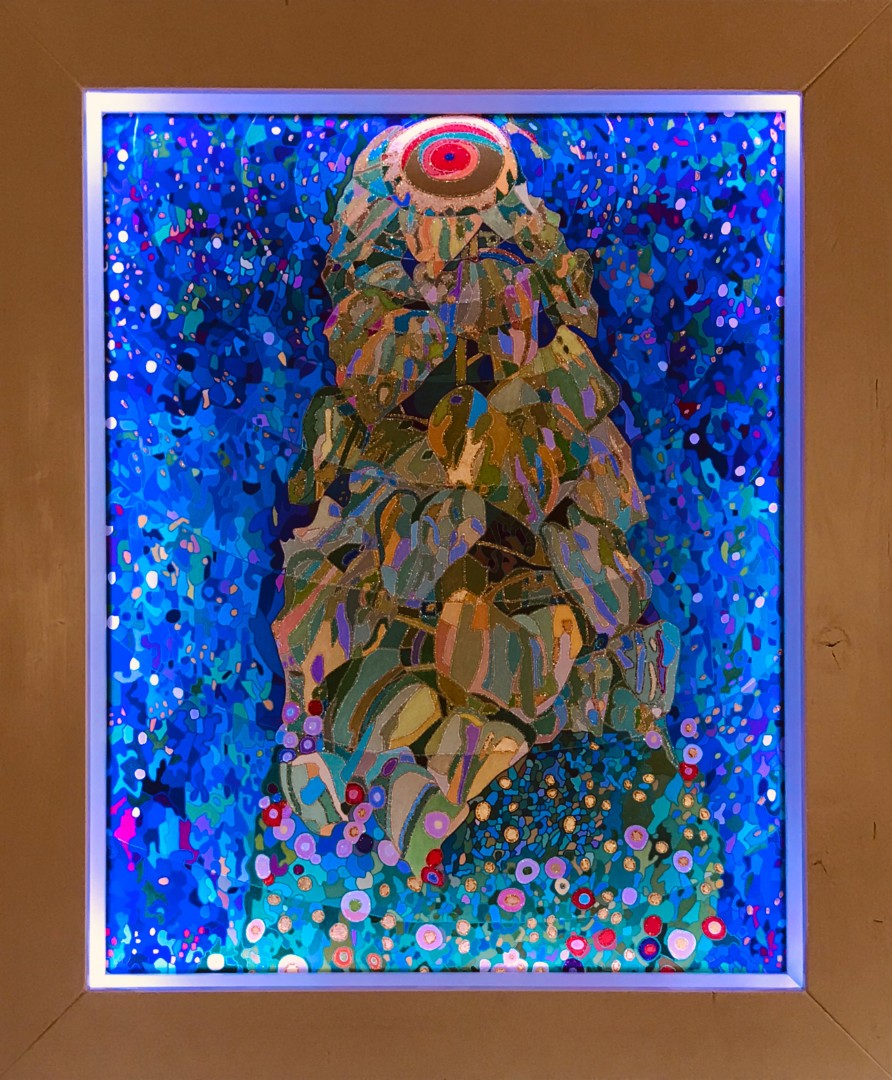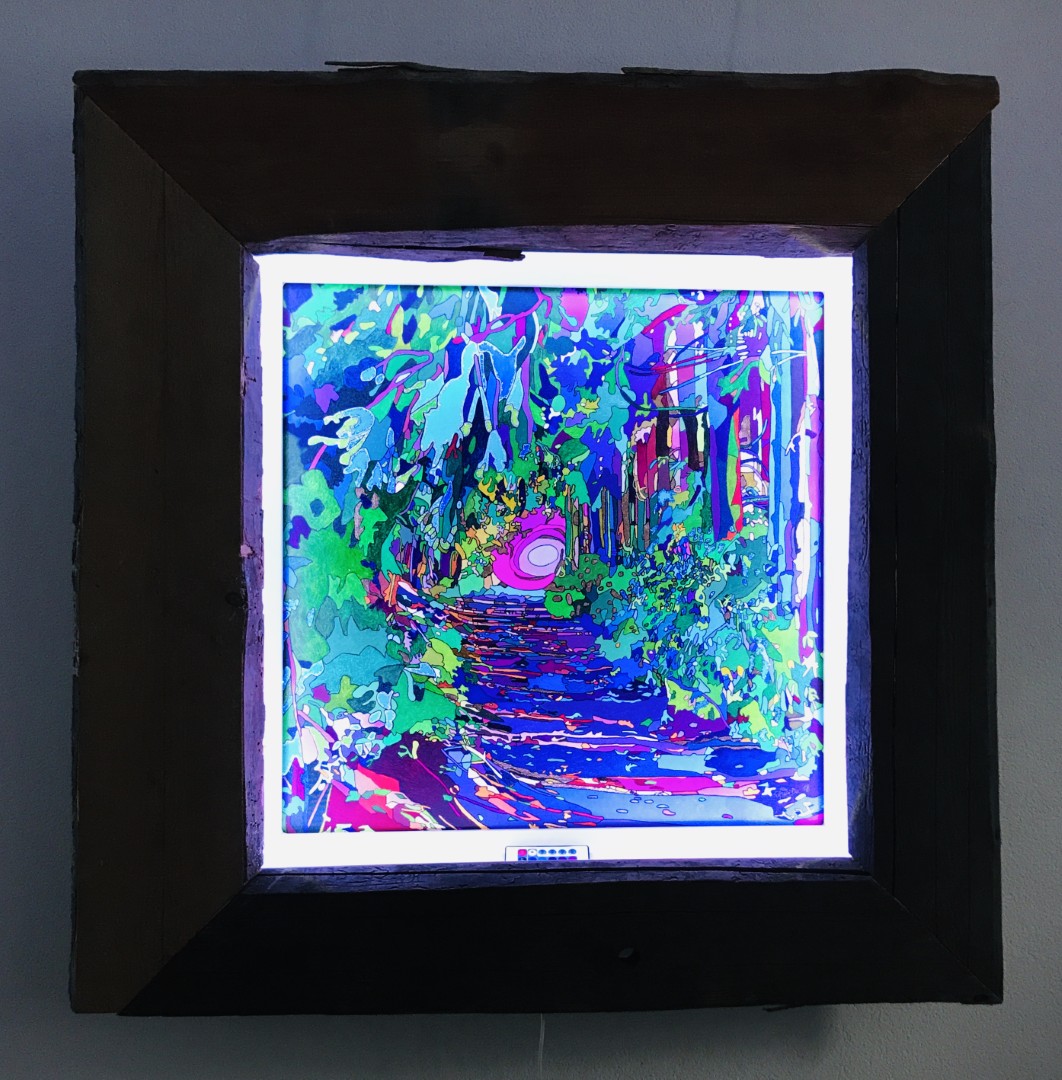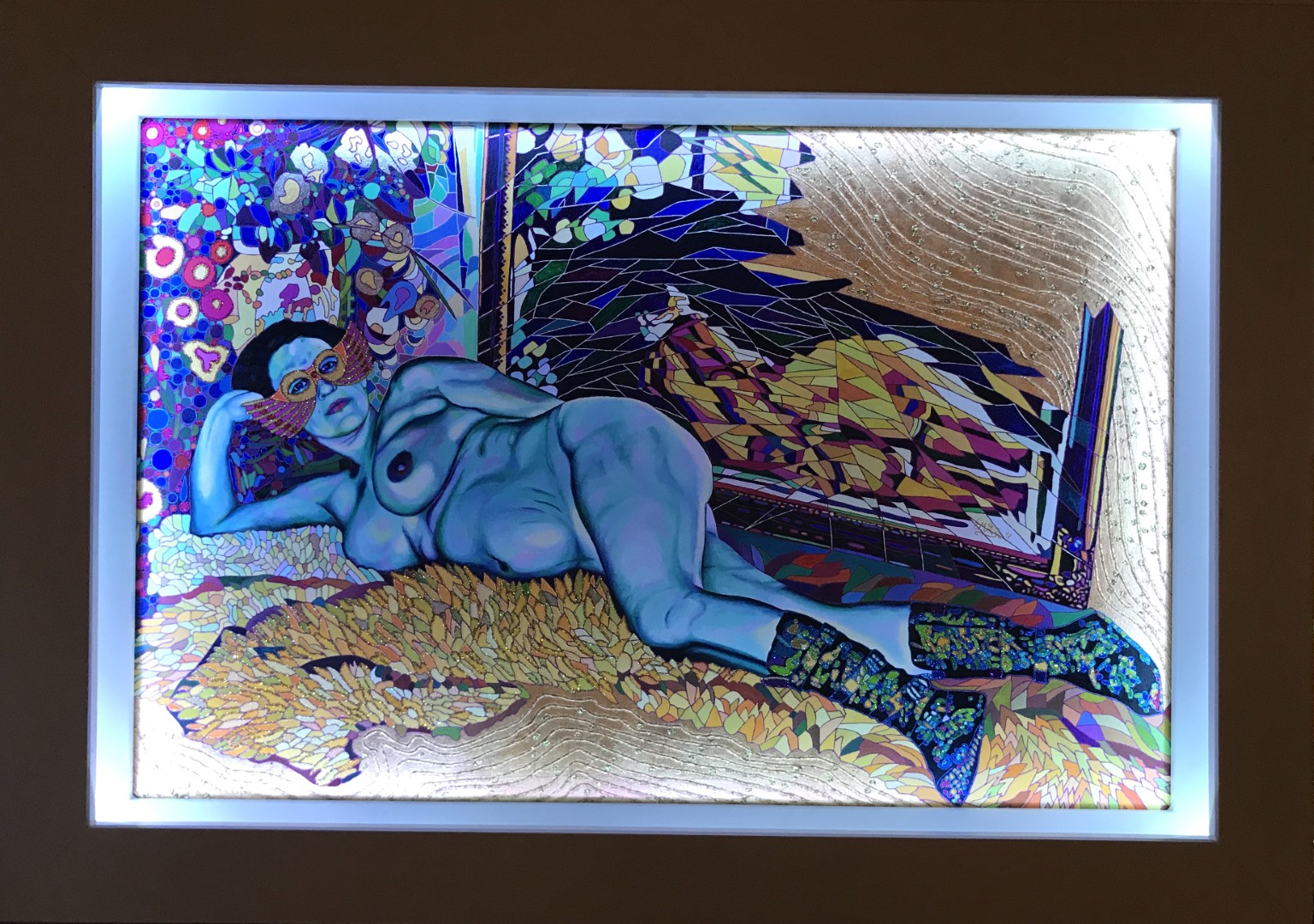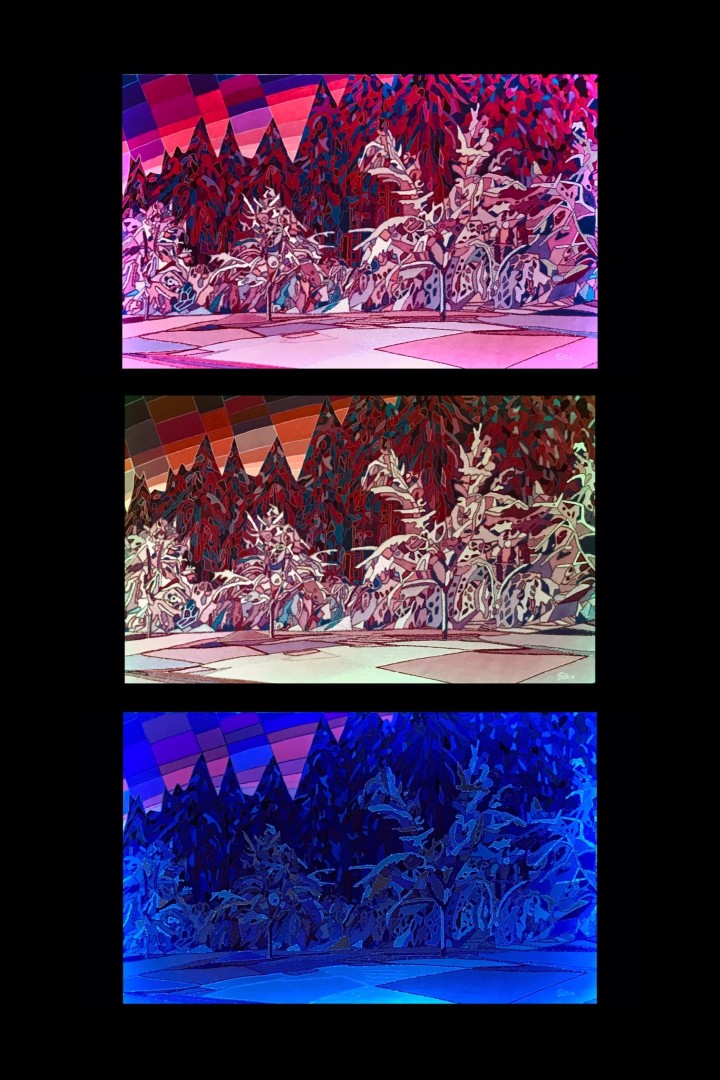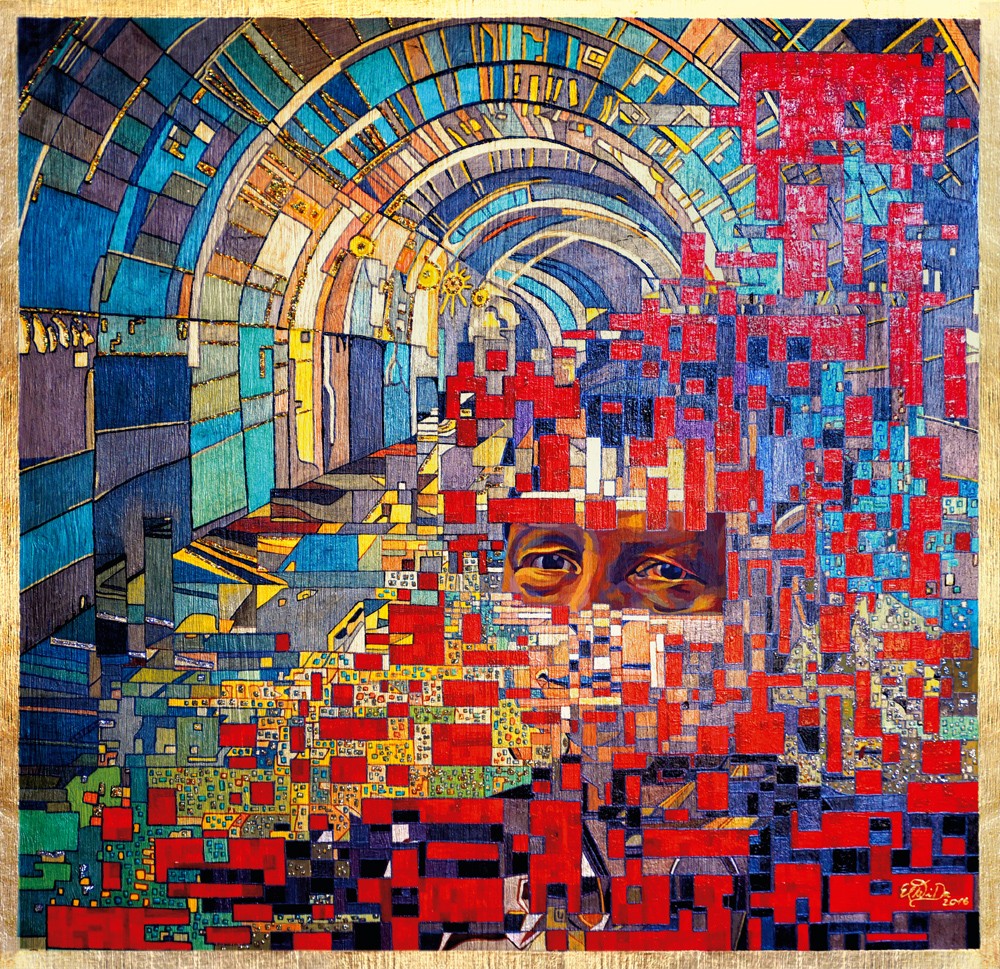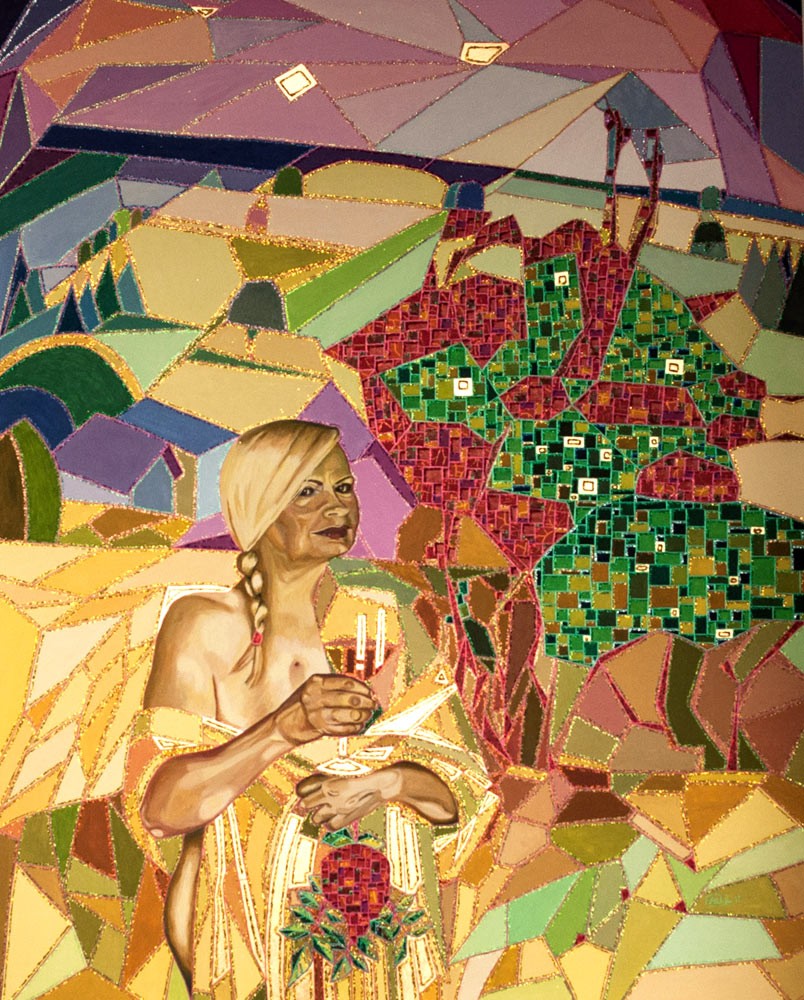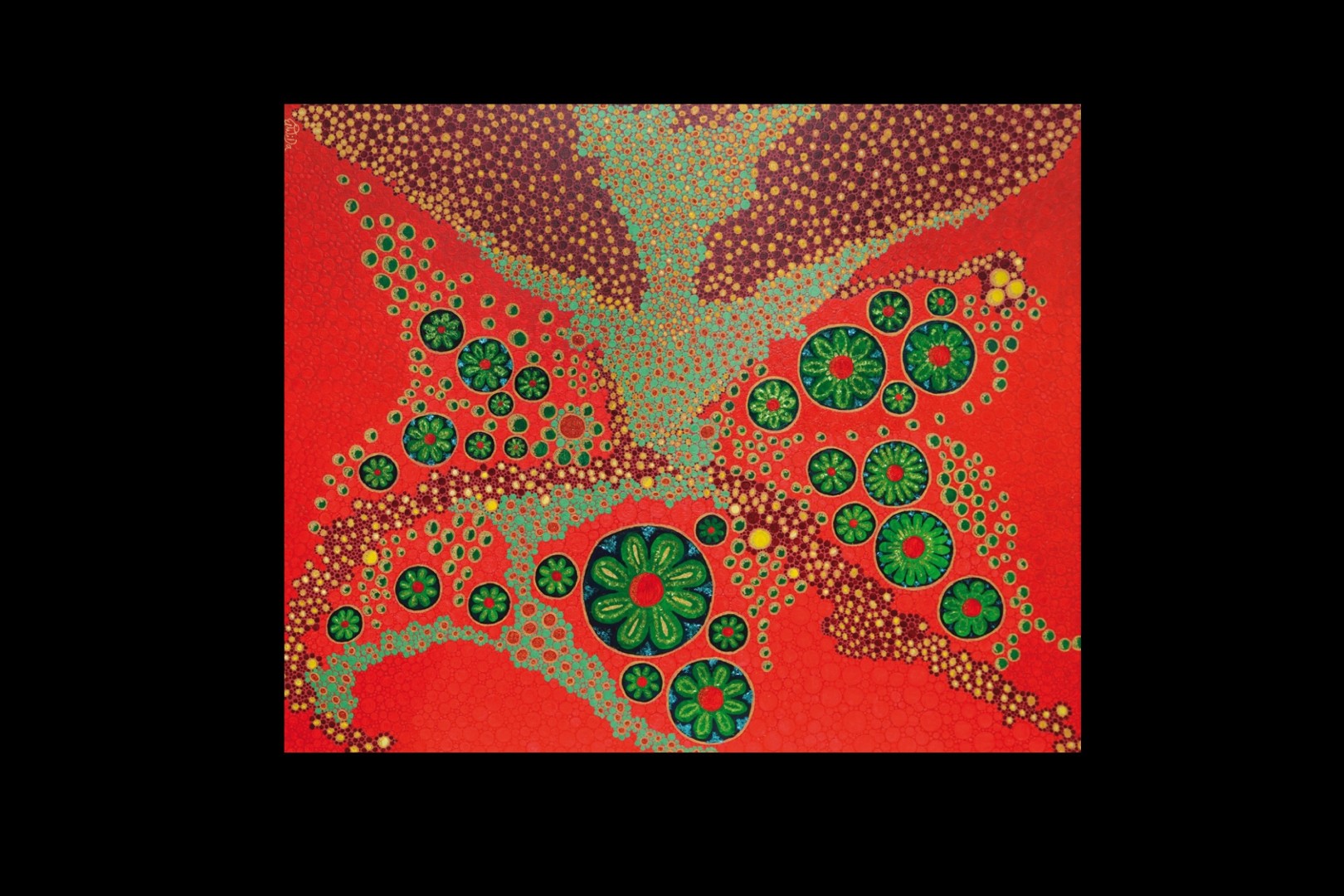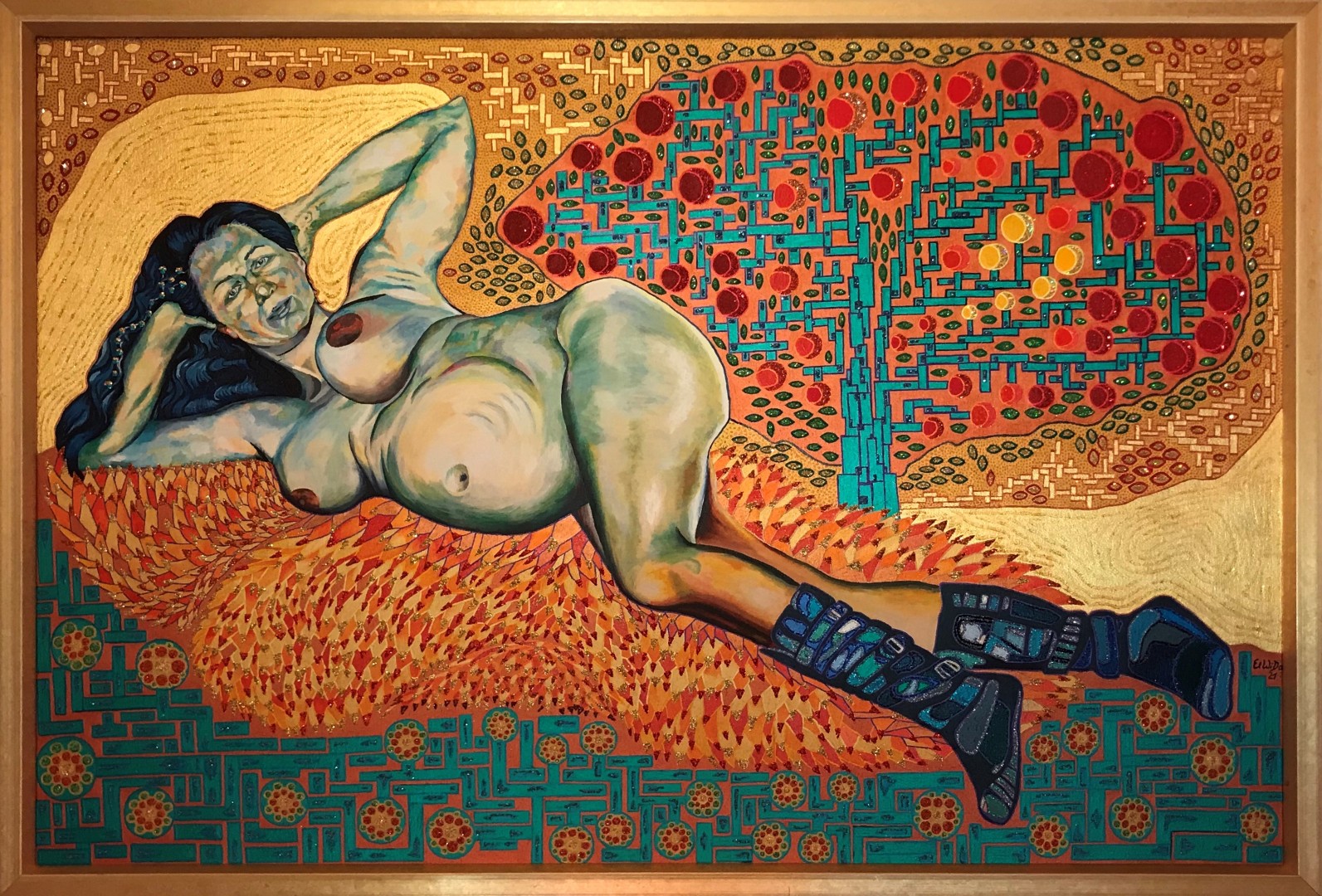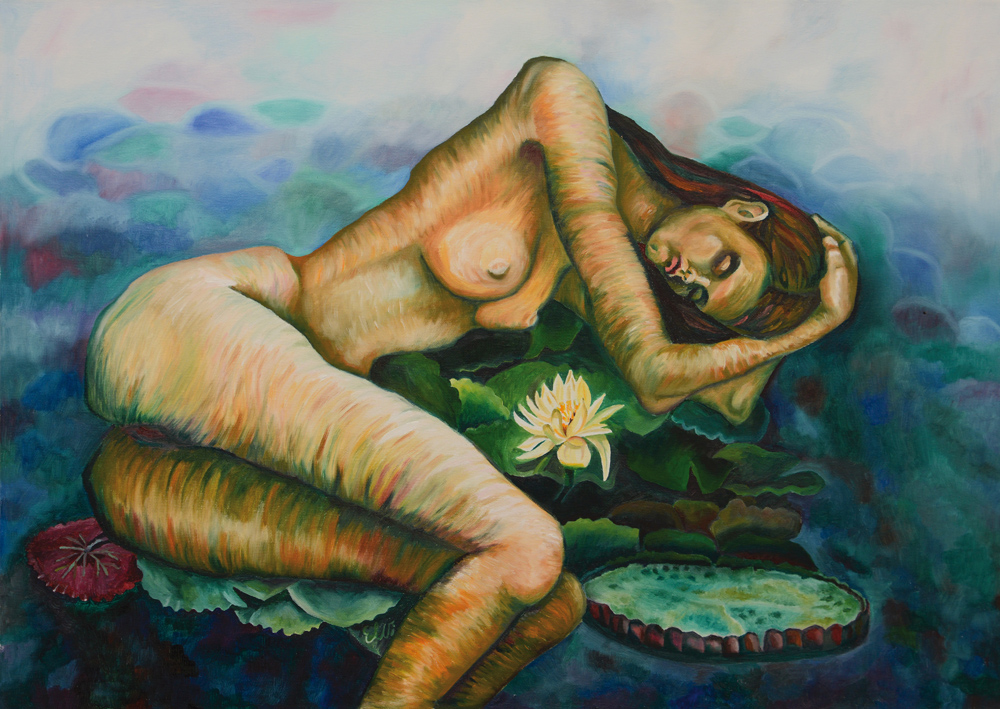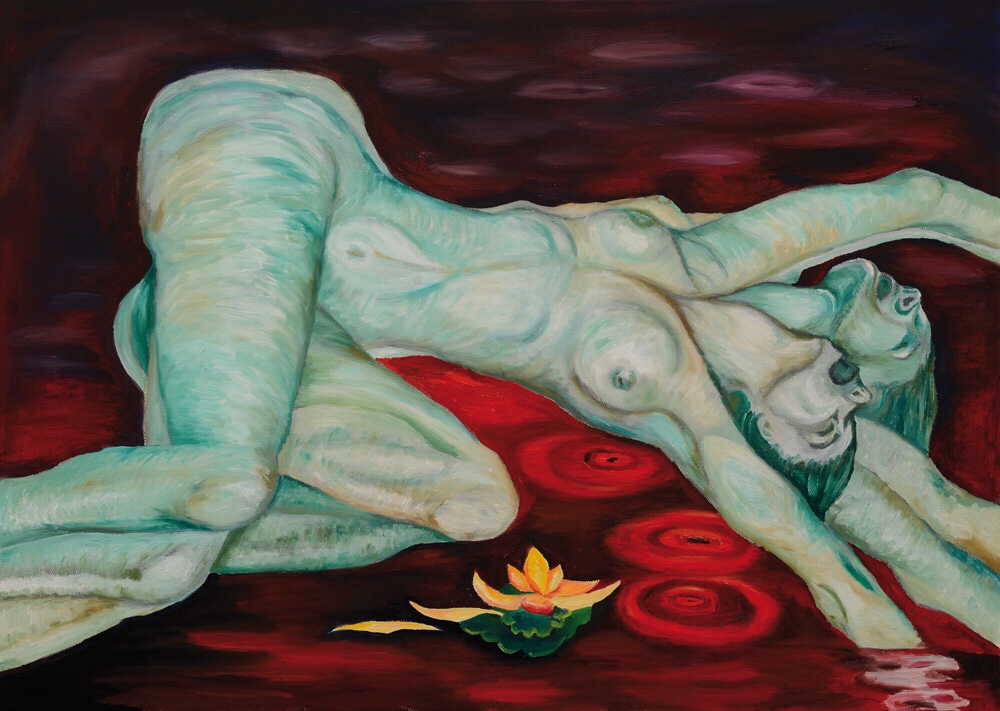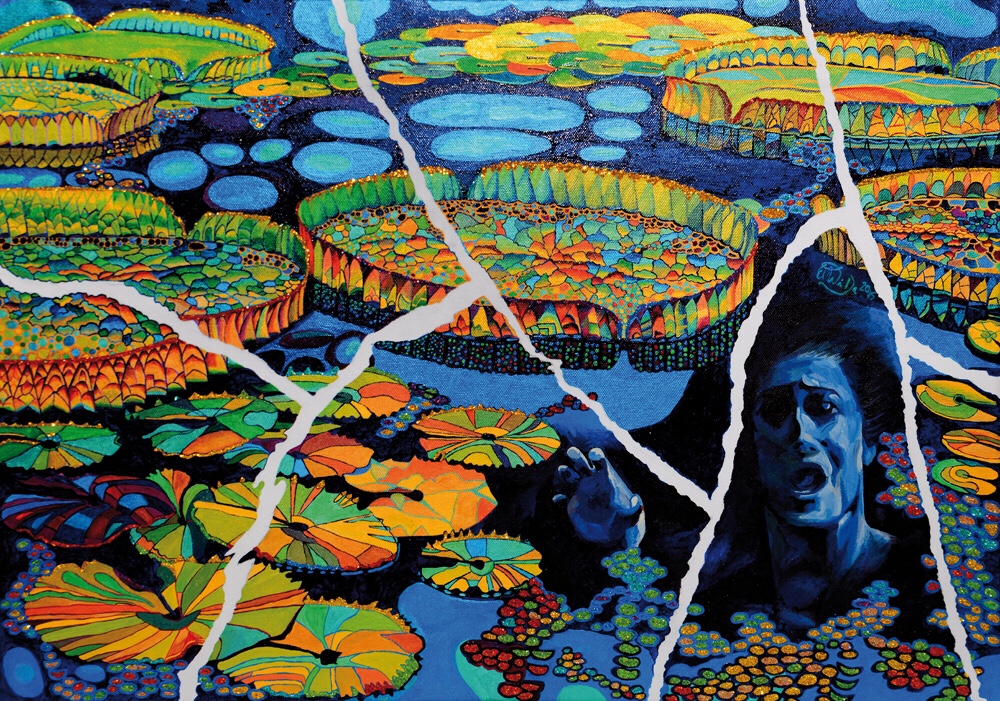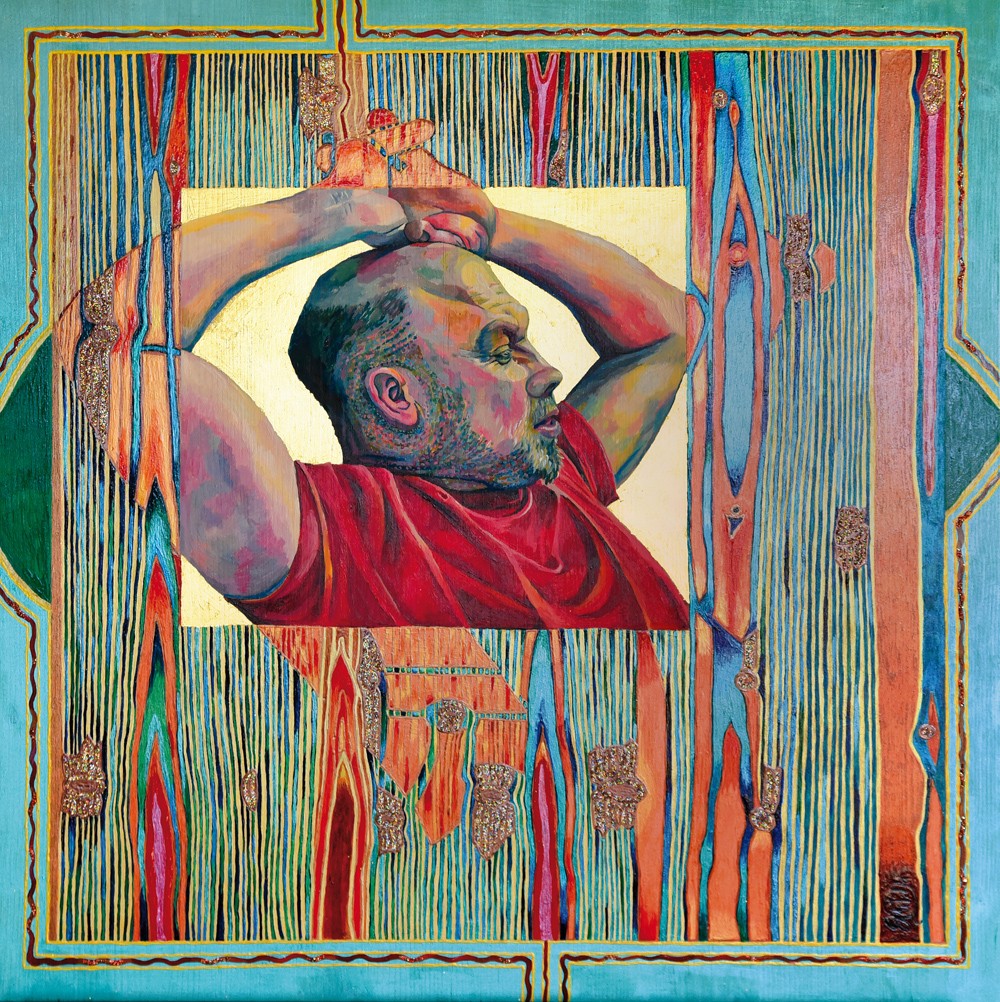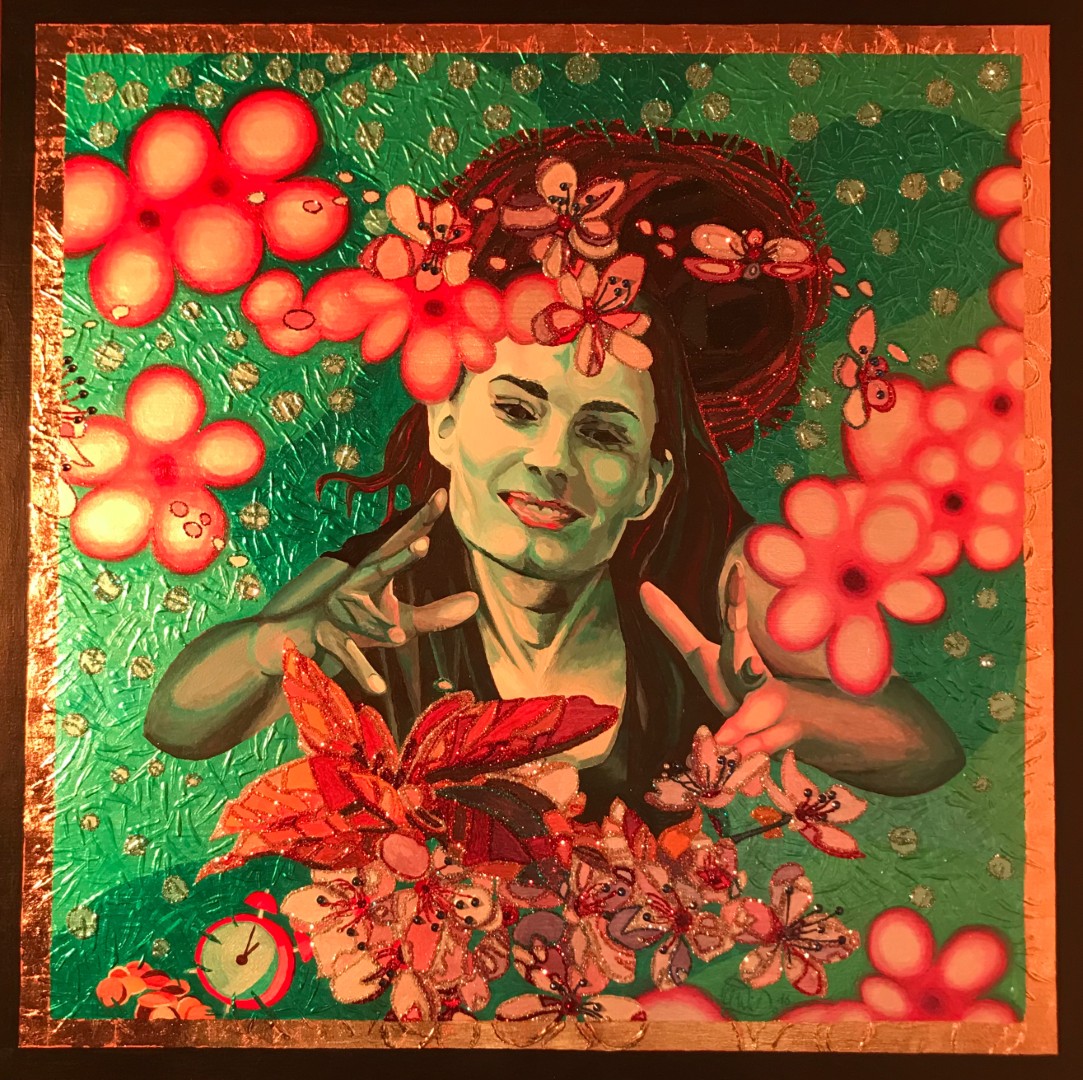Galerie zum Bild „Geschichte I“, 40 x 50 cm, Acryl auf HDF, 2023
gallery to the painting „Hystory I“, 40 x 50 cm, acrylic on HDF, 2023
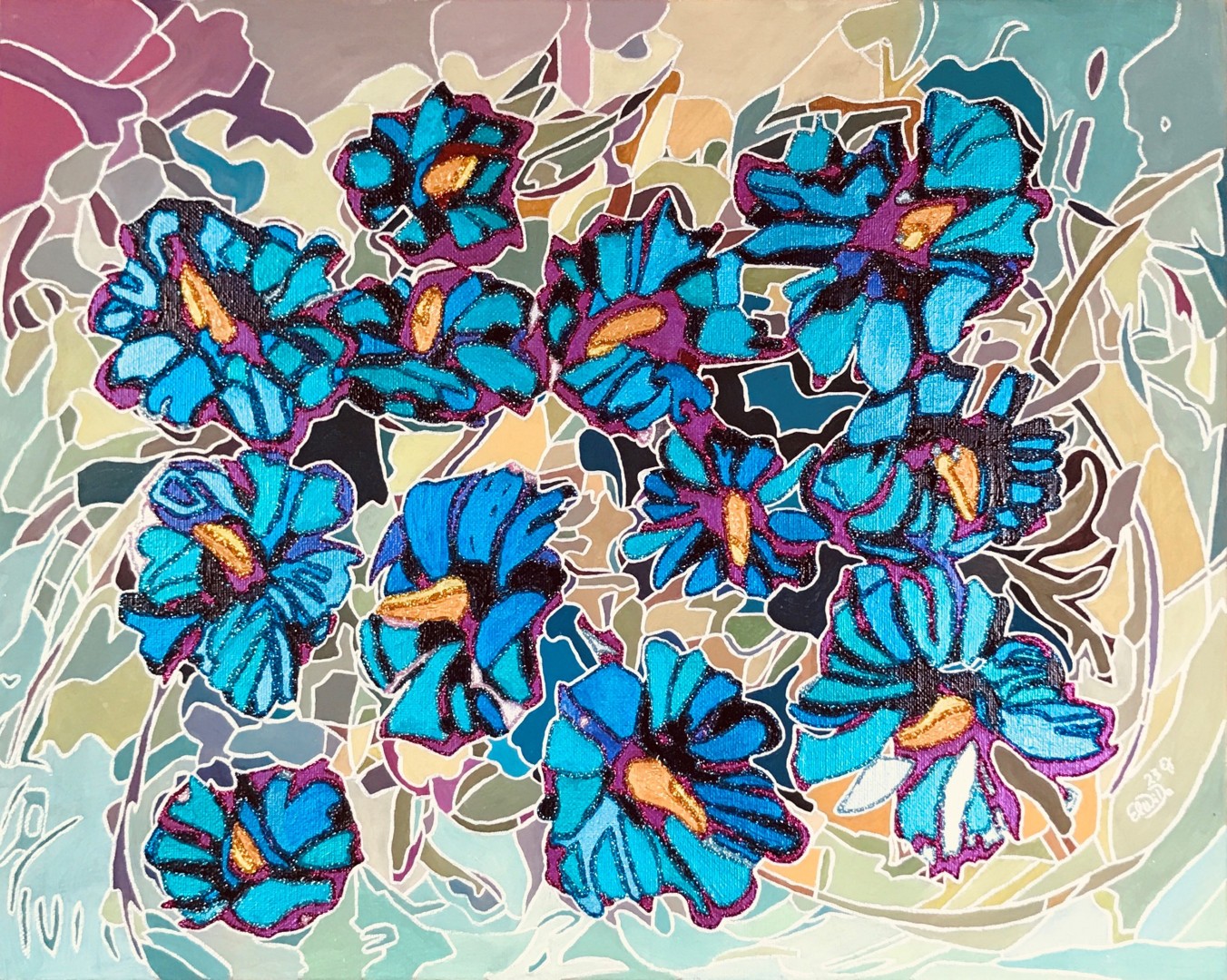
ungerahmt und unbeleuchtet
without frame and unlighted
„Geschichte I“ im Farbwechsel
„History I“ in colour change
Eine unvollendete Skizze meines Vater reizte mich sie zu vollenden. Komposition und Malstil brachte ich auf meine Art ein. So konnte ich nach seinem Tod bei ihm sein. Ein Strauß Blumen als Symbal der Freude, der Schönheit und des Lebens wurde somit zu einem neuen Motiv in meiner Mal
An unfinished sketch of my father tempted me to complete it. Composition and painting style I brought in my own way. So I could be with him after his death. A bouquet of flowers as a symbol of joy, beauty and life thus became a new motif in my painting.
Galerie zum Bild „Geschichte II“, 40 x 50 cm, Acryl auf HDF, 2023
gallery to the painting „Hystory II“, 40 x 50 cm, acrylic on HDF, 2023
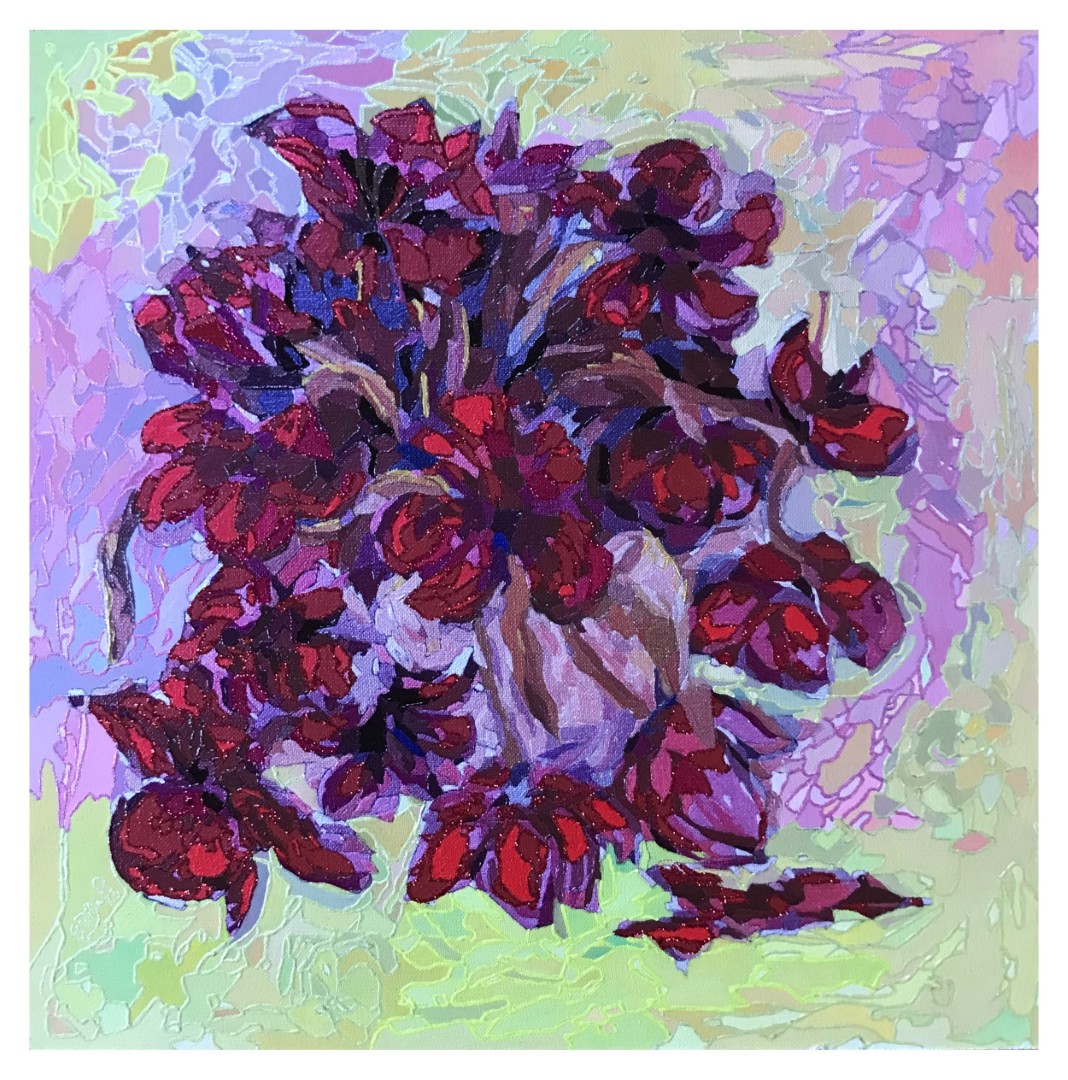
ungerahmt und unbeleuchtet
without frame and unlighted
„Geschichte II“ im Farbwechsel
„History II“ in colour change
Eine unvollendete Skizze meines Vater reizte mich sie zu vollenden. Komposition und Malstil brachte ich auf meine Art ein. So konnte ich nach seinem Tod bei ihm sein. Ein Strauß Blumen als Symbal der Freude, der Schönheit und des Lebens wurde somit zu einem neuen Motiv in meiner Mal
An unfinished sketch of my father tempted me to complete it. Composition and painting style I brought in my own way. So I could be with him after his death. A bouquet of flowers as a symbol of joy, beauty and life thus became a new motif in my painting.
Galerie zum Bild „Traum I“, 60 x 60 cm, Öl und Acryl auf Leinwand, 2023
Gallery to the painting „Dream I“, 60 x 60 cm, oil on canvas, 2023
Bild in Lichtfarbe Weiss
framed light colour white
Video mit Farbwechsel gefilmt mir KiraKira+
video in colour change filmed with KiraKira+
Der Rahmen um die Szenerie stellt das Unbewusste dar, die dominante, kranke Mutter und den kreativen, zurückhaltenden Vater, den starken Vogel im Flug als Verkörperung von Befreiung, auch gespiegelt im Wasser als Wiederspruch zwischen Welt und Scheinwelt, der Schmetterling als Symbol für die unsterbliche Seele, den Baum als das Symbol für die menschliche Entwicklung, die Vergänglichkeit und die Verwurzelung mit einer Gemeinschaft. Alle Symbole sind durch eine besondere Gelschicht hervorgehoben und mit glitzerndem Staub umrahmt Die rechte Frau scheint nicht ängstlich zu sein, sie zieht den Betrachter durch die Augen in den Bann und verbindet sich über ihre Hand mit der Hirschkuh als Zeichen von Verständnis und Anerkennung.
Das Unbewusste beeinflusst das Traumgeschehen: Symbole aus dem äußeren Rahmen gelangen in den Traum, das Innere des Bildes. Durch den Farbwechsel springen die Symbole hervor und verdeutlichen den gewaltigen Einfluss des Unbewussten.
The frame around the scene represents the unconscious, the dominant, sick mother and the creative, reserved father, the strong bird in flight as the embodiment of liberation, also mirrored in the water as the contradiction between the world and the illusory world, the butterfly as the symbol of the immortal soul, the tree as the symbol of human development, transience and rootedness with a community. All the symbols are highlighted by a special layer of gel and framed with glittering dust The woman on the right does not appear to be afraid, she draws the viewer in through her eyes and connects with the hind through her hand as a sign of understanding and recognition.
The unconscious influences the dream events: Symbols from the outer frame enter the dream, the inside of the picture. Through the change of colour, the symbols jump out and illustrate the powerful influence of the unconscious.
Galerie zum Bild „Suche“, 80 x 100 cm, Öl und Acryl auf HDF, 2023
Gallery to the painting „Search“, 80 x 100 cm, oil on HDF, 2023
im Rahmen Lichtfarbe Weiss
framed light colour white
„Suche“ im Farbwechsel 2 gefilmt mit KiraKira+
„Search“ in colour change filmed with KiraKira+
Galerie zum Bild „Davor und Danach/ Adaption Selbstbildnis meines Vaters“, 60 x 60 cm, Öl und Acryl auf Leinwand, 2022
Gallery to the painting „Bevore and After/ Adapted Self-portrait From my Father“, 60 x 60 cm, oil on canvas, 2022
im Rahmen Lichtfarbe Weiss
framed light colour white
„Davor und Danach“ im Farbwechsel gefilmt mit KiraKira+
„Bevore and After“ in colour change filmed with KiraKira+
Galerie zum Bild „Der grüne Esel – Electra Adaption“, 140 x 80 cm, Öl auf Leinwand, 2021
gallery to the painting „The Green Dinkey Electra – adapted“, 140 x 80 cm, oil on canvas, 2021
im LuxoFrame Lichtfarbe Weiss
in LuxoFrame light colour white
„Der grüne Esel Electra – Adaption“ gefilmt mit KiraKira+
„The Green Donkey Electra adapted“ filmed with KiraKira+
Öl auf Leinwand, 2021, 80 x 140 cm, gerahmt im LuxoFrame 114 x 178 cm
Link zum Song: https://youtu.be/h8YqJ95XXmk
Informationen zum Text des Songs: https://de.wikipedia.org/wiki/Der_gr%C3%BCne_Esel_(Lied)
In diesen Zeiten, unter dem Eindruck, Künstler hielten sich zurück im Umgang mit der aktuellen politischen Situation, kam mir die Idee, das Lied von Electra zu adaptieren, eine neue Strophe in Form eines Bildes zu schreiben:
Ein grün bemalter Esel mit roten Beinen steht am steilen Abhang, blickt zurück auf den goldenen Weg (Oder ist es gar ein Holzweg?), gesäumt mit weißen Callas und Vergissmeinnicht am Wegesrand, hält inne vor dem letzten Schritt, der ihn im Abgrund verschwinden lassen wird.
Gezogen wird der Esel von einem unsichtbaren, sehr wohlhabenden Lenker. Das durch ihn angelegte goldene Geschirr lässt ein Abweichen vom Weg nicht zu.
Der goldene Weg versteckt eine Frage (binär), die in den Steinen eingemeißelt ist.
Im Hintergrund sind aufgetürmt wie Mikado Unmengen an blutigen Stäben, wie eine Aufforderung, diese Zeitzeugen behutsam zu beräumen, wie im oben genannten Spiel.
Odin hat uns sein linkes Auge als Pfand überlassen, um in die Zukunft sehen zu können.
Was werden wir erblicken?
Der Rahmen zum Bild soll die Wirkung des „Herunterziehens“ verstärken. Das Holz stammt von einer 300 Jahre alten Scheune, die gerade entkernt wurde.
Oil on canvas, 2021, 80 x 140 cm, framed in LuxoFrame 114 x 178 cm
Link to the song: https://youtu.be/h8YqJ95XXmk
Information about the lyrics of the song: https://de.wikipedia.org/wiki/Der_gr%C3%BCne_Esel_(Lied)
In these times, under the impression that artists are holding back in dealing with the current political situation, I had the idea to adapt the song by Electra, to write a new verse in the form of a picture:
A green-painted donkey with red legs stands on the steep slope, looking back at the golden path (Or is it even a wooden path?), lined with white callas and forget-me-nots along the way, pausing before the last step that will make him disappear into the abyss.
The donkey is pulled by an invisible, very wealthy driver. The golden harness put on by him does not allow him to deviate from the path.
The golden path hides a question (binary) carved in the stones.
In the background, piled up like Mikado, are heaps of bloody sticks, like an invitation to gently clear these witnesses, as in the game above.
Odin has given us his left eye as a pledge to see into the future.
What will we behold?
The frame to the picture is meant to reinforce the effect of „pulling down“. The wood comes from a 300-year-old barn that has just been gutted.
Galerie zum Bild „Unterm Eis“, 60 x 60 cm, Öl und Acryl auf Leinwand, 2021
Gallery to the painting „Under the Ice“, 60 x 60 cm, oil and acrylic on canvas, 2021
im Rahmen Lichtfarbe Blau
framed light colour blue
„Unterm Eis“ im Farbwechsel gefilmt mit KiraKira+
„Under the ice“ in colour change filmed with KiraKira+
Ausgangspunkt für das Bild „Unterm Eis“ ist ein Ereignis, das in unserer Gesellschaft ein Tabu-Thema ist, das aber näher betrachtet in vielen gleich gelagerten Fällen gerade heute, zur Corona-Zeit, immer und immer wieder passiert. Das Leben verlangt Entscheidungen. Entscheidungen haben Konsequenzen für den Menschen, der sie fällt, für die ihn liebenden und das Subjekt der Entscheidung, unabhängig davon, ob das Resultat der Entscheidung gewollt, unbeabsichtigt oder in guten Absichten entstand. Das Motiv der Entscheidung will ich nicht bewerten, aber das Bild beginnt genau beim Resultat der Entscheidung und wirft die Frage auf: Was ist „Schuld“, hört sie jemals auf? Kann man ein Mitwirken an Entscheidungen, deren Konsequenz die Verhinderung oder das Beenden von Leben ist, verdrängen? Packt man diese entstehenden Gefühle unter Eis, in Kälte und Dunkelheit und läuft dabei Gefahr, dass Eis taut und somit sichtbar wird, was besser im Verborgenen bleiben sollte?
Das einzufangen, war das Ziel: Sobald blaues Licht auf das Bild trifft, liegt alles im Verborgenen. Bezaubernde Elemente im Eis laden zum Träumen ein. Verzückt kann man sich der Vollkommenheit der Natur hingeben. Doch wenn immer mehr rote Bestandteile im Licht auf die gemalte Situation treffen, beginnt ein tiefer Absturz: Das Hochgefühl gleitet in Bestürzung. Denn es wird frei gelegt, was uns erschüttert, so dass der Anblick kaum zu ertragen ist.
Um die meine Gefühlswelt zu verstärken, habe ich auf dem Blendrahmen die Piano-Noten zum Stück „Dream 3“ vom Max Richter gemalt. Dieses Stück beim Betrachten gehört, komplettiert das Bild.
Die vollständigen Lichtvarianten sind zum Schutz von Personen, die sich nicht dieser Gefühlswelt nicht aussetzen können, nur auf der Internetseite Elwida.de zu sehen.
The starting point for the painting „Under the Ice“ is an event that is a taboo subject in our society, but which, when looked at more closely, happens again and again in many similar cases, especially today, at Corona time. Life demands decisions. Decisions have consequences for the person who makes them, for those who love him and for the subject of the decision, regardless of whether the result of the decision was intentional, unintentional or made with good intentions. I do not want to evaluate the motive of the decision, but the picture begins precisely with the result of the decision and raises the question: What is „guilt“, does it ever end? Can one repress a participation in decisions whose consequence is the prevention or ending of life? Does one pack these emerging feelings under ice, in cold and darkness, running the risk of ice thawing and thus making visible what should better remain hidden?
Capturing this was the goal: as soon as blue light hits the picture, everything is hidden. Enchanting elements in the ice invite you to dream. Enraptured, one can surrender to the perfection of nature. But when more and more red elements in the light hit the painted situation, a deep crash begins: the elation slides into dismay. For what shakes us is exposed, so that the sight is hardly bearable.
To intensify my feelings, I have painted the piano notes to the piece „Dream 3“ by Max Richter on the frame. Listening to this piece while looking at it completes the picture.
For the protection of people who cannot expose themselves to this emotional world, the complete light variations can only be seen on the website Elwida.de.
Galerie zum Bild „Einander“, 140 x 80 cm, Öl und Acryl auf Leinwand, 2021
Gallery to the painting „Each Other“, 140 x 80 cm, oil and acrylic on canvas, 2021
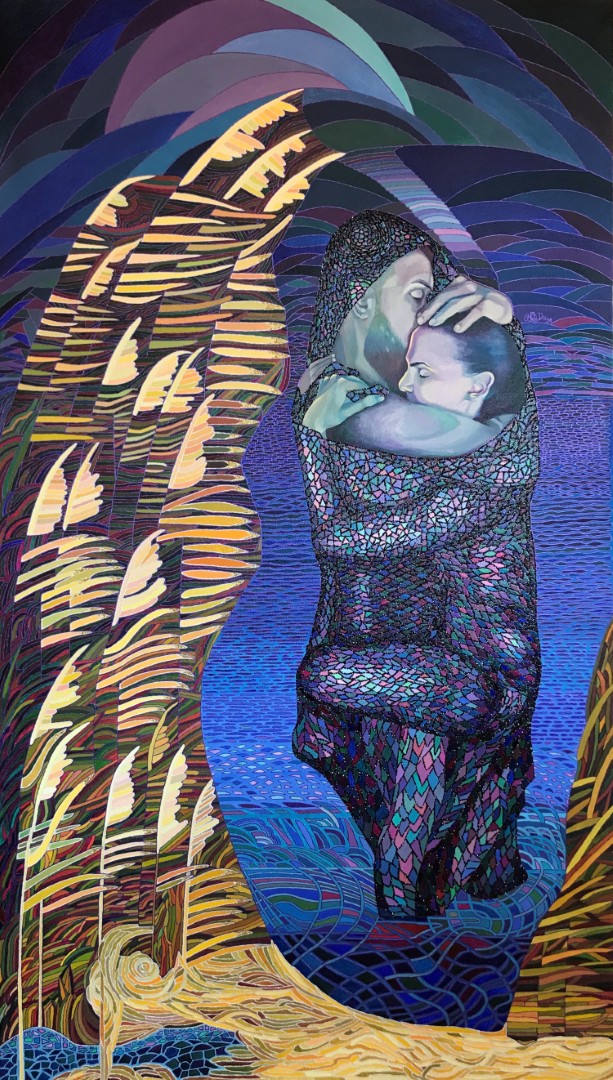
ohne Rahmen Tageslicht
without frame daylight
Jedoch die ZWEI haben EINANDER.
Und es ist schon passiert:
Die Schilfgrasspitzen unter der Wasseroberfläche, symbolisch verborgene Verletzungen, lassen den Tragenden bluten.
Der MAGISCHE UMHANG, erhaben dargestellt, mit Essenzen getränkt, die die ZWEI suchten, fanden, verwarfen und wiederfanden,beschützt sie. Beschützt EINANDER vor allem nicht Beinflussbaren.
Mit welchen Essenzen ist der MAGISCHE UMHANG getränkt?
Vertrauen in EINANDER: Trotz allem Ungemach vertraut jeder der ZWEI dem anderen. „Einer mag überwältigt werden, aber ZWEI können widerstehen…“ (Prediger 4:12) Der Ur-Reflex, wegzurennen, erscheint nicht als Lösung.
Aufopferung für EINANDER: Nur er steht für sie im kalten Wasser und nimmt Verletzungen unter Wasser durch das nicht Sichtbare in Kauf.
Fürsorge für EINANDER: Sie beschützt ihn, indem sie den MAGISCHEN UMHANG über seine Schultern zieht und hilft ihm beim Tragen, indem sie sich an ihn klammert, so dass die ZWEI einen festen Stand – Gleichgewicht finden. Die Wärme des einen wärmt auch den anderen. Hände beschützen Empfindliches zusätzlich.
Nähe zu EINANDER: Die ZWEI spüren in der innigen Umarmung EINANDER, ihre Herzschläge. Jede Emotion wird unter dem MAGISCHEN UMHANG offen.
ZWEI haben im MAGISCHEN UMHANG ein kostbares Gut. Ein Gut, das man nicht geschenkt bekommt. Ein Gut, das man sich erarbeiten muss. Ein Gut, das man bewahren, beschützen und verteidigen sollte.
Ich wünsche mit diesem Gemälde allen, dass sie ZWEI werden und EINANDER sein können; mit einem ganz individuellen MAGISCHEN UMHANG, dessen Werte sie selbst bestimmen.
However, the TWO have EACH OTHER.
And it has already happened:
The reed tips under the surface of the water, symbolically hidden injuries, make the wearer bleed.
The MAGIC CAPE, sublimely depicted, impregnated with essences, which the TWO
were looking for, found, discarded and found again, protects them.
Protect EACH OTHER from all that cannot be influenced.
With what essences is the MAGIC SURROUNDING imbued?
Trust in EACH OTHER: Despite all adversity, each of the TWO trusts the other. „One may be overcome, but TWO can withstand…“ (Ecclesiastes 4:12) The primal reflex to run away does not appear to be the solution.
Sacrifice for EACH OTHER: Only He stands in the cold water for them and accepts injury under water from what is not visible.
Caring for EACH OTHER: She protects him by pulling the MAGIC HANG over his shoulders and helps him carry it by clinging to him so that the TWO find a firm footing – balance. The warmth of one also warms the other. Hands provide additional protection for sensitive things.
Closeness to EACH OTHER: The TWO feel EACH OTHER, their heartbeats, in the intimate embrace. Every emotion becomes open under the MAGIC CAPE.
TWO have a precious commodity in the MAGIC CAPE. A good that is not given as a gift. A good that one has to work for. A good that should be preserved, protected and defended.
With this painting I wish everyone that they can become TWO and be EACH OTHER; with a very individual MAGIC CAPE, the values of which they determine themselves.
Galerie zum Bild „Kontroverse“, 120 x 80 cm, Öl auf Leinwand, 2020
Gallery to the painting „Kontroverse“, 120 x 80 cm, oil on canvas, 2020
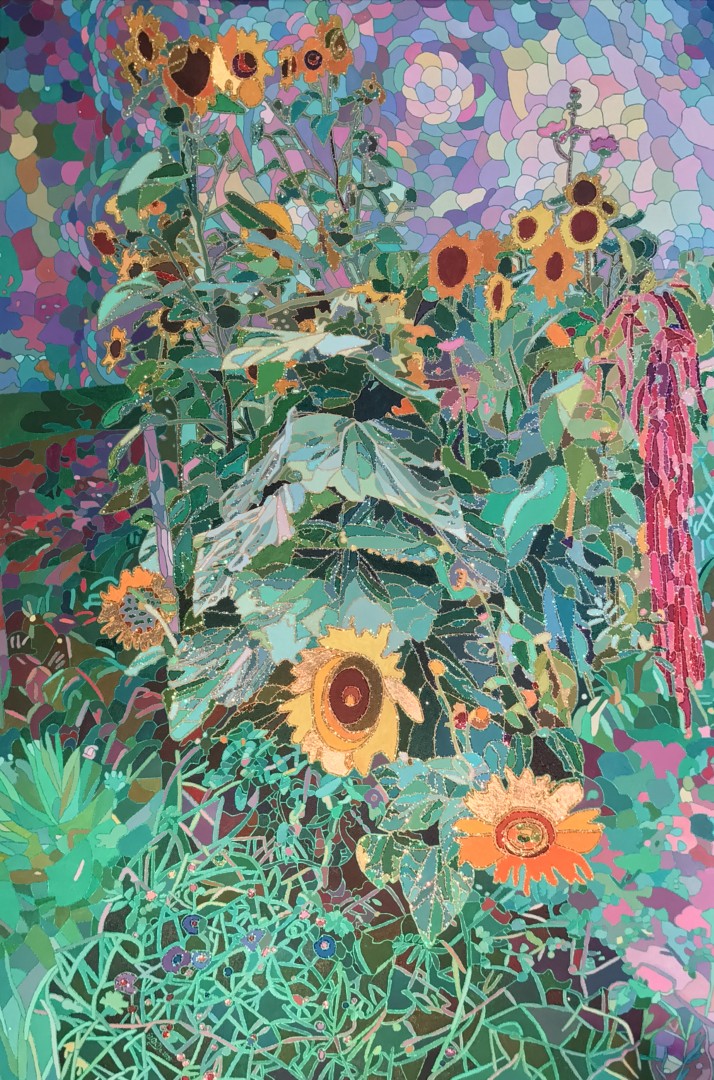
ohne Rahmen Tageslicht
without frame daylight
„Kontroverse“ im Farbwechsel
„Kontroverse“ in colour change
Sieh die beiden Platzhirsche, die sich ihrer Sache und ihrer Stellung sicher, sich mit ihrer Meinung durchzusetzen scheinen.
Und der Fuchsschwanz ist echauffiert, an den Rand gedrängt und plustert sich auf, hilflos und schlaff leistet er keinen essentiellen Beitrag, nur heiße Luft ist zu erwarten, aber gut sieht er aus.
Die etwas schmalere Sonnenblume an der Seite der Platzhirsche träumt abwesend vor sich hin, wendet sich ab und ist nicht bei der Sache, sie wird ein ihr nahe stehendes Problem wälzen. Erst die Faust auf dem Tisch (im übertragenen Sinne) wird sie aus ihrer Gedankenwelt reißen.
Sogar eine eingeschnappte Leberwurst habe ich etwas oberhalb der Bildmitte gefunden (oder versteckt). Sie ist durch nichts und durch niemanden zu überzeugen, ein Nihilist sozusagen.
Die jungen Blumen, aufsteigend, aber zerbrechlich tummeln sich entgegen der Sonne, als gäbe es keinen Morgen, undiszipliniert und vollkommen anderer Meinung mischen sie den Laden auf, mit ihrer Lust am Leben und sich fortpflanzen. Sie scheinen andere Wege versuchen zu wollen.
So sind die Blumen scheinbar nicht anders in ihrem Sein, kontrovers, kommunikativ wie wir Menschen (wie die Wissenschaft bei Bäumen und Pflanzen schon nachgewiesen hat).
Der Wechsel der Lichtfarbe im LuxoFrame unterstützt die Räumlichkeit der Komposition und die Lebendigkeit des Bildes.
Galerie zum Bild „Erste Elegie – Rilke-Projekt“, 80 x 100 cm, Öl auf HDF, 2016
Gallery to the painting „First Elegy – Rilke-Project“, 80 x 100 cm, Oil on HDF, 2016
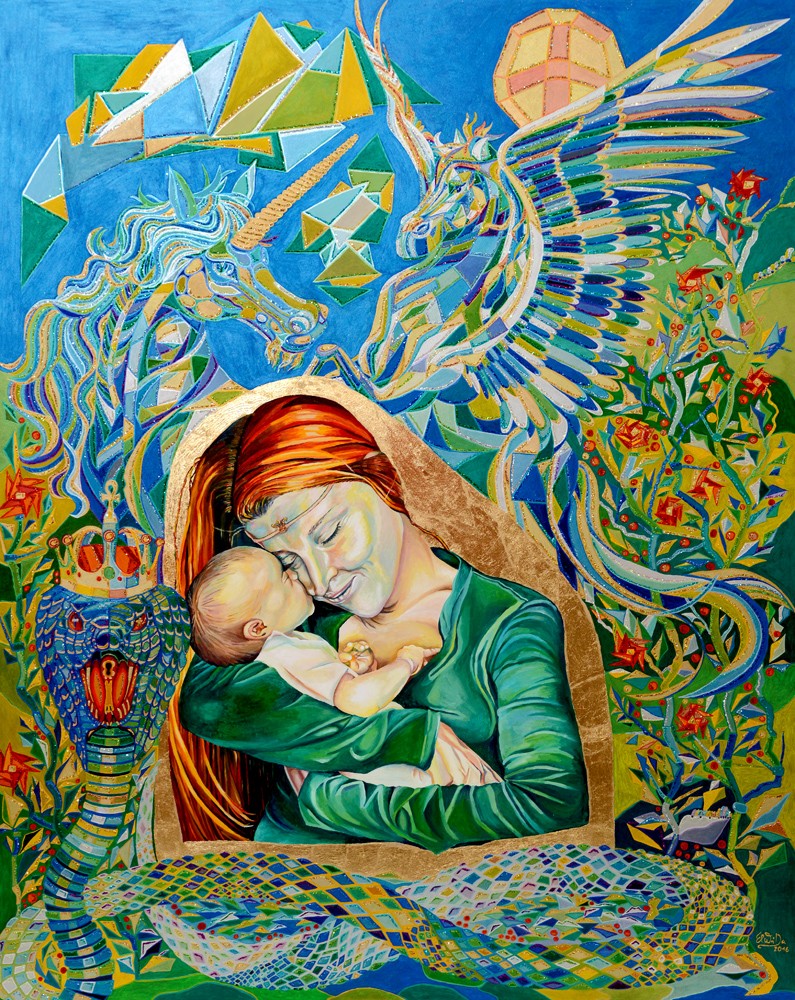
Lichtfarbe Weiss
light colour white
„Erste Elegie“ im Farbwechsel
„First Elegy“ in colour change
Auszug aus Rainer Maria Rilke: Duineser Elegien – Kapitel 1
Die erste Elegie
Wer, wenn ich schriee, hörte mich denn aus der Engel Ordnungen? Und gesetzt selbst, es nähme einer mich plötzlich ans Herz: ich verginge von seinem stärkeren Dasein. Denn das Schöne ist nichts als des Schrecklichen Anfang, den wir noch grade ertragen, und wir bewundern es so, weil es gelassen verschmäht, uns zu zerstören. Ein jeder Engel ist schrecklich…
Die Darstellung von Mutter und Kind wird seit langer Zeit in der Darstellenden Kunst immer wieder in Angriff genommen. Auf den ersten Blick strahlt Harmonie auf den Betrachter aus. Die Mutter mit dem Kinde als Königin des Guten. Um dieses Motiv zu verstärken, wurde es in einen goldenen Rahmen gesetzt, gleich den religiösen Ikonen (Maria mit dem Kinde). Auf den zweiten Blick steht im Vordergrund jedoch die Königskobra mit dem Ankh-Zeichen (Lebensschlüssel) in der Krone, die angriffslustig und drohend ihr Giftzähne in Stellung hält. Nicht nur Verteidigung sondern auch Angriff ist eine herausragende Fähigkeit von Müttern, wenn es darum geht, ihre Nachkommen zu schützen. Rosen, in den Himmel wachsend, halten Raupen aus, die fleißig an den Blättern nagen. Werden die Raupen die Rosen vernichten, bevor sie zu Schmetterlingen werden? Das Einhorn als das Sinnbild des Guten und Pegasus, das Pferd, das Mütter, wenn sie Geschichten erzählen, reiten schweben über Mutter und Kind. Der Mond in Form des Peace-Zeichens bedeutet Frieden als erste Voraussetzung für Mutter und Kind. Jedoch sind gerade Mutter und Kind immer wieder Ursache für Kriege, Streit und Auseinandersetzungen, wenn auch keineswegs durch sie selbst gewollt.
The First Elegy
Who, if I cried, would hear me, of the angelic orders? Or even supposing that one should suddenly carry me to his heart – I should perish under the pressure of his stronger nature. For beauty is only a step removed from a burning terror we barely sustain, and we worship it for the graceful sublimity with which it disdains to consume us. Each angel burns.
The depiction of mother and child has long been a recurring theme in the performing arts. At first glance, harmony radiates to the observer. The mother with the child as queen of good. To enhance this motif, it was placed in a golden frame, like the religious icons (Mary with the Child). At second glance, however, the king cobra with the Ankh sign (key to life) in its crown is in the foreground, holding its fangs in position in an aggressive and threatening manner. Not only defence but also attack is an outstanding skill of mothers when it comes to protecting their offspring. Roses, growing into the sky, endure caterpillars, which gnaw diligently on the leaves. Will the caterpillars destroy the roses before they become butterflies? The unicorn as the symbol of good and Pegasus, the horse, the mothers when they tell stories, riding, hovering over mother and child. The moon in the form of the peace sign means peace as the first condition for mother and child. However, especially mother and child are always the cause of wars, quarrels and conflicts, even if they are by no means wanted by themselves.
Galerie zum Bild „Hot“, 60 x 60 cm, Öl auf Leinwand, 2020
Gallery to the painting „Hot“, 60 x 60 cm, oil on canvas, 2020
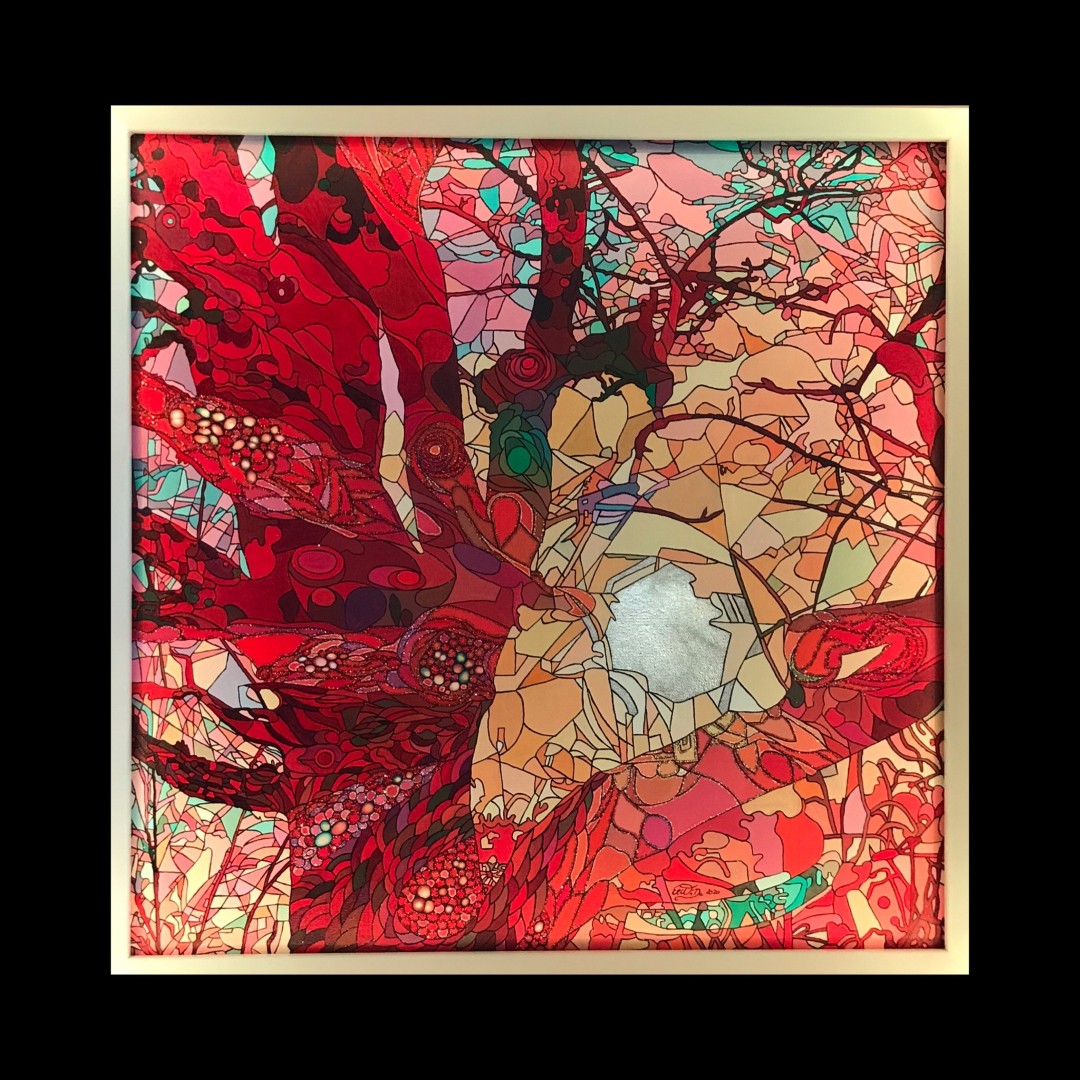
im LuxoFrame Lichtfarbe Weiss
in LuxoFrame light colour white
„Hot“ im Farbwechsel
„Hot“ on colour change
Um diese Metapher dreht sich das Bild. Was wir Menschen anderen Mitbewohnern auf unserem Planeten antun, wenn wir weiter so sorglos und egoistisch leben, kann jeder jetzt nachvollziehen, weil jeder weiß, dass Brandblasen, die der gezeigte Baum herausgebildet hat in der Glut der Sonne, Schmerzen auslösen, die unvergleichbar sind. Das leuchtende Glitzern bildet einen Kontrast dazu.
The picture revolves around these metaphor. Wat we humans are doing to other livings of our planet, if we continue to live so carefree and selfishly, everyone can now understand, because everyone knows that burn blisters, which the shown tree formed nation of the embers of the sun, cause pain that’s incomparable.
The luminous glitter forms a contrast.
Galerie zum Bild „Sleepless – Polarlights only for me“, 100 x 80 cm, Öl auf HDF, 2019
Gallery to the painting „Sleepless – Polarlights Only For me“, 100 x 80 cm oil on HDF, 2019
im LuxoFrame Lichtfarbe Violett
in LuxoFrame light colour purple
Video im Farbwechsel gefilmt mit KiraKira+
video in colour change filmed with KiraKira+
Galerie zum Bild „Bauerngarten Adaption (G. Klimt)“, 60 x 60 cm, Öl auf Leinwand, 2018
Gallery to the painting „Farmers Garden Adaption (G. Klimt)“, 60 x 60 cm, oil on canvas, 2018
im LuxoFrame Lichtfarbe Weiss
in LuxoFrame light colour white
Video im Farbwechsel gefilmt mir KiraKira+
video in colour change filmed with KiraKira+
Im Unterschied zum Original wird der Schwerpunkt für den Betrachter nicht nur auf die Blütenblätter geholt, sondern auf die gesamte Pflanze. Die Blätter kommen dadurch in die Ebene der Blüten. Ziel dieser Vorgehensweise war die Ansicht der Künstlerin, dass nicht nur die Blüte von Bedeutung ist, dass ohne die Blätter die Blüte nicht langfristig existieren kann, dass Blätter neben ihren uns bereits bekannten Aufgaben/ Funktionen vermutlich noch „Dinge“ erledigt, von denen wir nichts wissen, die aber von immanenter Bedeutung sind.
Unlike the original, the focus for the viewer is not only on petals, but on the entire plant. This brings the leaves into the level of the flowers. The aim of this approach was the artist’s view that not only the flower ist of importance, that without the leaves the flower cannot exist in the long term, that leaves, in addition to their tasks/ functions already known to us, probably still do „things“ that we know nothing about, but which ar of immanent of importance.
Galerie zum Bild „Die galaktische Sonnenblume – Adaption (G. Klimt)“, 100 x 80 cm, Öl auf Leinwand, 2019
Gallery to the painting „Galactic Sunflower – Adaption (G. Klimt)“, 100 x 80 cm, oil on canvas, 2019
Video gefilmt mit KiraKira+
video filmed with KiraKira+
Als Mittelpunkt des Universums wählte ich die Blüte aus, von ihr gehen konzentrische Kreise in immer weitere Entfernung. Jedes Blatt, jede Blume, alles erhält Licht und damit Wärme. Selbst im entferntesten Winkel werfen kleinste Flächen wie Sterne das Licht zurück. Die Präsenz über diesen Bildaufbau soll dem Betrachter zurufen: siehe, hier bin ich und ich tue dir Gutes und allen ringsherum.
I choose the flower as the center of the universe, from which concentric circles go further and further away. Every leaf, every flower, everything receives light and thus warmth. Even at the most distant angle, the smallest surfaces reflect the light like stars. The presence above this painting structure should call out to the observer: see, here I am and I do good to you and all around you.
Galerie zum Bild „Baum“, 80 x 100 cm, Öl auf HDF, 2017
Gallery to the painting „Tree“, 80 x 100 cm, oil on HDF, 2017
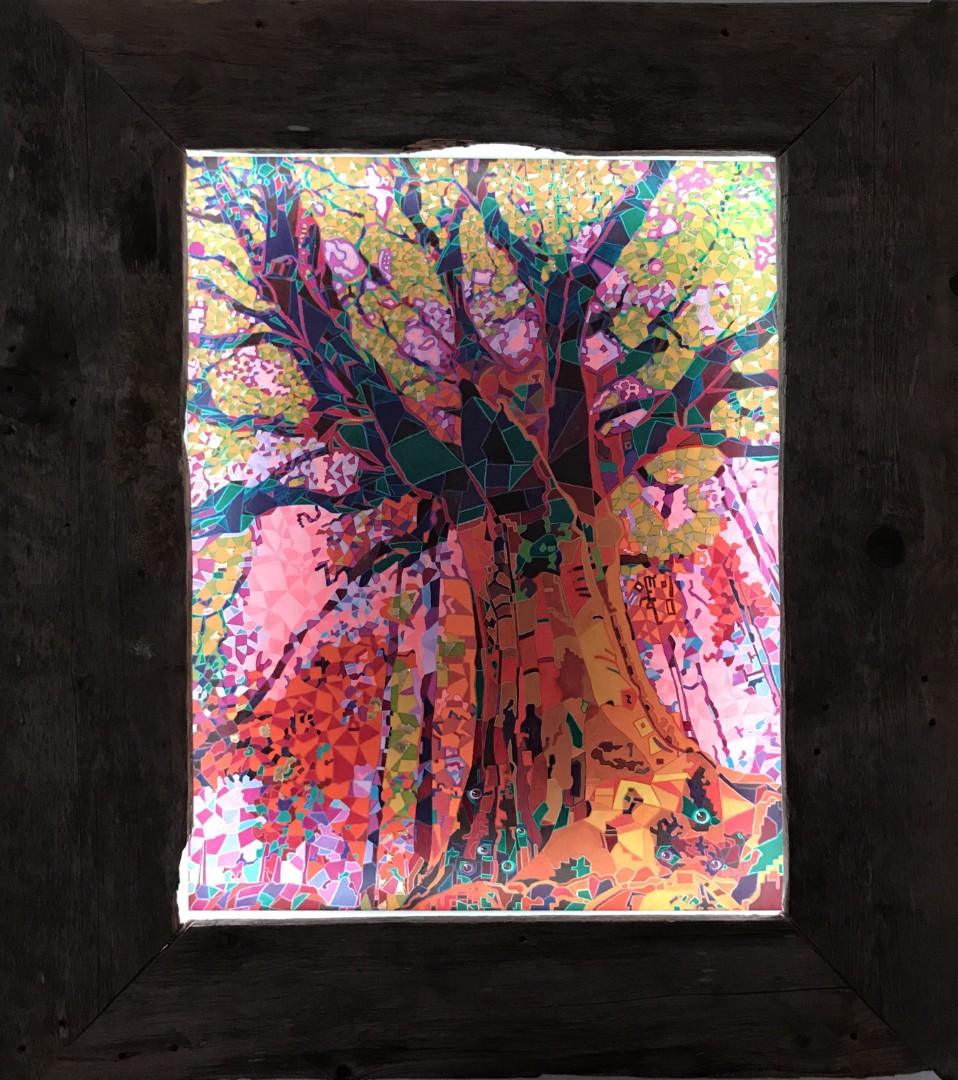
im LuxoFrame Lichtfarbe Weiss
in LuxoFrame colour light white
Rühr mich nicht an! Oder: ich sehe alles, was du mir antust!
Goldene Blätter flirren beim Standortwechsel des Betrachters. Farbiges Licht verwandelt die Situation in eine Abendstimmung (blaues Licht) in Frühling (gelbes Licht) oder sommerliche Glut (rotes Licht). Der Rahmen aus altem Holz unterstützt die Wirkung des Bildes.
im Farbdurchlauf
in colourchange
A magnificent tree with enchanted undergrowth. Eyes look and warn:
Don’t touch me! Or: I see everything you do to me!
Golden leaves shimmer when the observer changes his position. Coloured light transforms the situation into an evening mood (blue light) into spring (yellow light) or summer glow (red light). The frame of old wood supports the effect of the picture.
Galerie zum Bild „Wald bei Wolkenstein“, 60 x 60 cm, Öl auf Leinwand, 2018
gallery to the painting „Forest Near Wolkenstein“, 60 x 60 cm, oil on canvas, 2018
im LuxoFrame Lichtfarbe Weiss
in LuxoFrame light colour white
Video im Farbwechsel gefilmt mir KiraKira+
video in colour change filmed with KiraKira+
Galerie zum Bild „Self-Definition“, 80 x 120 cm, Öl auf Leinwand, 2018
gallery to the painting „Self-Definition“, 80 x 120 cm, oil on canvas, 2018
im LuxoFrame Lichtfarbe Weiss
in LuxoFrame light colour white
„Self-Definition“ im Farbwechsel
„Self-Definition“ in colour change
Galerie zum Bild „Pas de deux im Winterwald“, 104,5 x 65 cm, Acryl auf Leinwand, 2018
gallery to the painting „Pas De Deux In Winter Forest“, 104,5 x 65, acrylic on canvas, 2018
in verschiedenen Farben ohne Rahmen
in different colours withaout fram
Video im Farbwechsel gefilmt mit KiraKira+
video in colour change filmed with KiraKira+
The snow-covered trees seem to reach out to each other, as in the Pas de Deux. Glittering, frozen snow fascinates the viewer. Metallic acrylic in the foreground makes the landscape appear spatial. Coloured light transforms the situation from sunset over deep night to sunrise. The viewer is invited to walk the glittering path in the frozen snow towards the winter forest and to dance along.
Galerie zum Bild „Nur ein Augenblick“, 60 x 60 cm, Acryl auf Holz, 2016
gallery to the painting „Blink of an Eye“, 60 x 60 cm, acrylic on wood, 2016
im LuxoFrame Lichtfarbe Weiss
in LuxoFrame colour light white
Video im Farbwechsel gefilmt mit KiraKira+
video in colour change filmed with KiraKira+
Galerie zum Bild „Herbsttag – Rilke-Projekt“, 80 x 100 cm, Acryl auf HDF, 2017
gallery to the painting „Autumn Day – Rilke-Project“, 80 x 100 cm, acrylic on HDF, 2017
Lichtfarbe weiss ohne Rahmen
colour light white without frame
„Herbsttag“ im Farbwechsel
„Autumn Day“ in colour change
Herr, es ist Zeit. Der Sommer war sehr groß. Leg deinen Schatten auf die Sonnenuhren, und auf den Fluren lass die Winde los.
Befiehl den letzten Früchten, voll zu sein; Gib ihnen noch zwei südlichere Tage, dränge sie zur Vollendung hin, und jage die letzte Süße in den schweren Wein.
Wer jetzt kein Haus hat, baut sich keines mehr. Wer jetzt allein ist, wird es lange bleiben, wird wachen, lesen, lange Briefe schreiben und wird in den Alleen hin und her unruhig wandern, wenn die Blätter treiben.
Passend zum Gedicht ist dieses Bild an einem Herbsttag entstanden. Gleich hinterm Haus lässt sich genau dieser Vogelbeerbaum mit diesem Ausblick dahinter finden. Der würzige Duft des Herbstes lässt den Betrachter in eine gelassene Zufriedenheit gleiten. Elwida hat sich in ihrer Lebenssituation dargestellt, lädt entwaffnend und verletzlich zum Genießen ein.
Lord: it is time. The summer was immense.
Lay your shadow on the sundials
and let loose the wind in the fields.
Bid the last fruits to be full;
give them another two more southerly days,
press them to ripeness, and chase
the last sweetness into the heavy wine.
Whoever has no house now will not build one anymore.
Whoever is alone now will remain so for a long time,
will stay up, read, write long letters,
and wander the avenues, up and down,
restlessly, while the leaves are blowing.
Matching the poem, this picture was taken on an autumn day. Just behind the house you can find exactly this rowan tree with this view behind it. The spicy scent of autumn lets the viewer slide into a serene contentment. Elwida has portrayed herself in her life situation, inviting disarmingly and vulnerable to enjoy.
Galerie zum Bild „Schwarzes Schaf“, 120 x 100 cm, Acryl auf Leinwand, 2010
gallery to the painting „Black Sheep“, 120 x 100 cm, Acrylic on canvas, 2010
ohne Rahmen und unbeleuchtet
without frame and unlighted
Video im Farbwechsel gefilmt mit KiraKira+
video in colour change filmed with KiraKira+
„Blumen-Claudia“ im Farbwechsel
Flower-Claudia“ in colour change
Galerie Seerosen-Mädchen, 3 Teile, 70 x 50 cm, Öl und Acryl auf Leinwand, 2011 ff.
gallery painting „Water Lily Girl“, 3 parts, 70 x 50 cm, oil and acrylic on canvas, 2011 continuing
Seerosen-Mädchen 2: Unter dem Eindruck dieses Ereignisses versuchte ich ihre Wut in ein weiteres Bild zu packen. Ich sammelte Material über Techniken, die die Bewegung gut wieder gaben. Willi Sittes ständige Ausstellung in Merseburg gab mir genügend Stoff, die Technik zu finden, um den Todeskampf des Seerosenmädchens darzustellen. Bei mir es gibt kein Bild, das ich je gemalt habe, was so schnell fertig wurde. Bewusst habe ich am Ende der Entwurfsphase abgebrochen.
Seerosen-Mädchen 3: Einige Jahre nach dem zweiten Bild fand ich, dass es Zeit wird, das Vergessen um diesen schlimmen Tag aufzuarbeiten. Wenn man nicht selbst betroffen ist, gerät schnell in Vergessenheit, was nicht vergessen werden sollte. Die Geschichte der Jahre seit 2011 sagt uns immer wieder, dass unser Leben unbeschützt nicht gefahrlos ist. Such die Seerosenblüte auf dem wieder zusammengesetzten Foto! Verschwunden ist sie, ein für alle mal, weil man einen Irren gewähren ließ. Ich habe ganz bewusst die Technik Acryl-Metallic-Glitter eingesetzt, um zu provozieren. Hauptsache, wir vergessen nicht.
Water lily girl 2: Under the impression of this event I tried to pack her anger into another picture. I collected material about techniques that reflected the movement well. Willi Sitte’s permanent exhibition in Merseburg (Germany) gave me enough material to find the technique to depict the Water Lily Girl’s death struggle. There is no painting, I have ever painted so quickly. I deliberately broke off at the end of the design phase.
Water Lily Girl 3: Some years after the second painting, I thought it was time to work through the forgetting around that terrible day. If one is not affected oneself, it is easy to forget what should not be forgotten. The history of the years since 2011 tells us again and again that our life is not safe without protection. Find the water lily blossom in the reassembled photo! It disappeared, once and for all, because a lunatic was allowed to do so. I have deliberately used the technique of acrylic-metallic glitter to provoke. The main thing is that we do not forget.
Galerie zum Bild „Tom“, 60 x 60 cm, Acryl auf Holz, 2016
gallery to the painting „Tom“, 60 x 60 cm, acrylic on wood, 2016
ungerahmt
without frame
„Tom“ im Farbwechsel
„Tom“ in colour change
Galerie zum Bild „Du musst das Leben nicht verstehen (Rilke-Projekt)“, 60 x 60 cm, Acryl auf Holz, 2016
gallery to the painting „You do Not Have to Understand Life – Rilke-Project“, 60 x 60 cm, acrylic on wood, 2016
ungerahmt und unbeleuchtet
without frame and unlighted
„Du musst das Leben nicht verstehen“ im Farbwechsel
„You do Not Have to Understand Life“ in colour change
Du musst das Leben nicht verstehen, dann wird es werden wie ein Fest.
Und lass dir jeden Tag geschehen so wie ein Kind im Weitergehen von jedem Wehen sich viele Blüten schenken lässt.
Sie aufzusammeln und zu sparen, das kommt dem Kind nicht in den Sinn.
Es löst sie leise aus den Haaren, drin sie so gern gefangen waren, und hält den lieben jungen Jahren nach neuen seine Hände hin.
You must fail to understand life; then it will turn to festival.
And let every day happen to you as a child, in passing, from every breeze, accepts a gift of many blossoms.
To gather and to save them, that doesn’t occur to the child.
She loosens them gently from her hair, in which they so gladly were tangled, and, to youth’s sweet years, holds her hands stretched out for more.

